There are many things to love about the Philippines. This archipelago in Southeast Asia is home to some of the best beaches and most beautiful islands in the world. It’s also home to an amazing array of tropical fruits, some of which you’ve probably never heard of let alone tried.
In my opinion, the Philippines and Thailand are home to the best fruits in Southeast Asia. If you have a taste for tropical fruit and want to try as many exotic varieties as you can, then keep reading to learn about 30 delicious fruits in the Philippines that you absolutely must try.
Save This on Pinterest!
No time to read this article on Filipino fruits? Click on the save button and pin it for later!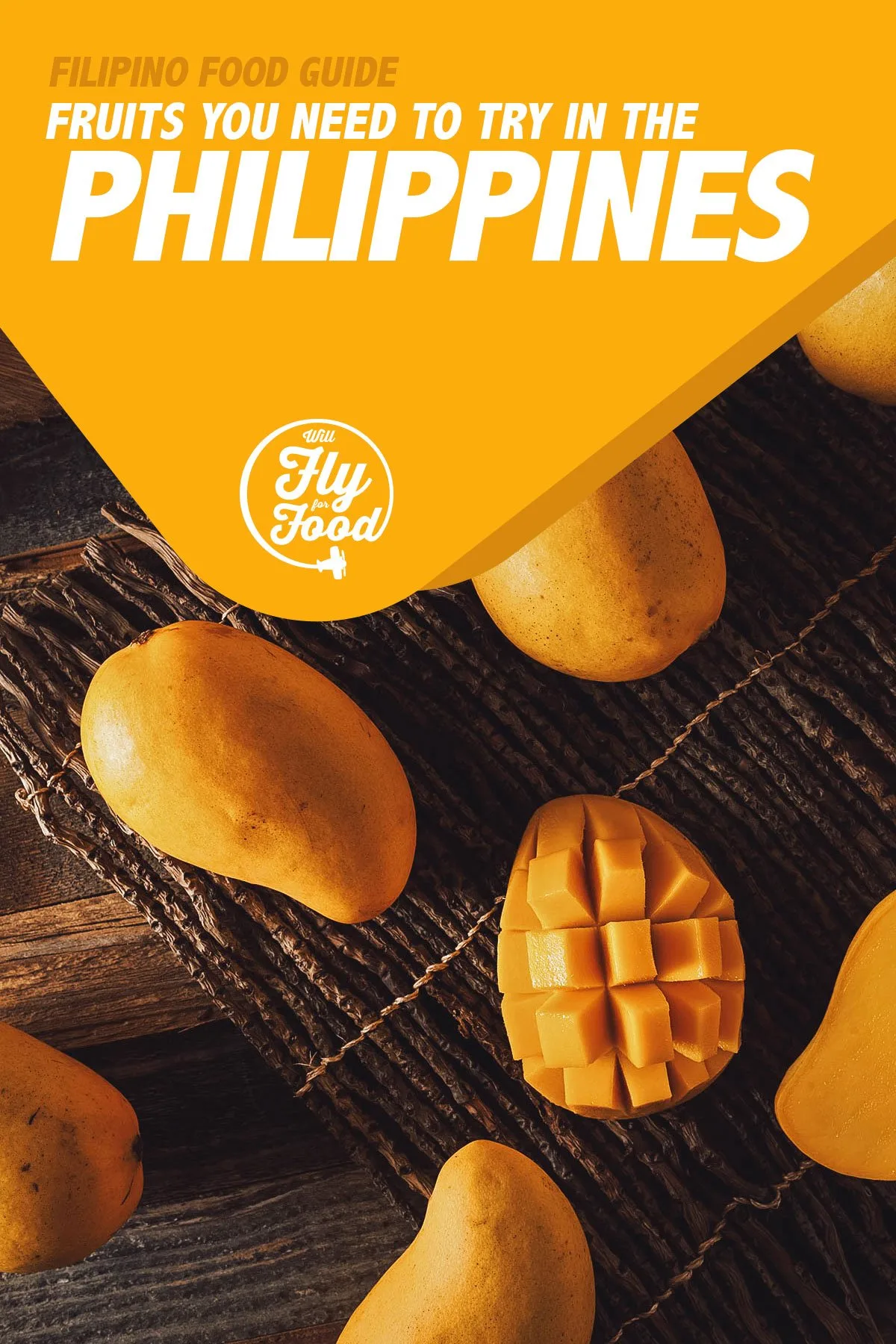
Photo by bhofack2
FREQUENTLY ASKED QUESTIONS ABOUT FILIPINO FRUITS
Before we dive into this list of the most delicious and exotic Filipino fruits, let’s answer a few commonly asked questions about the fruits in the Philippines.
1. What fruits and vegetables are native to the Philippines?
I can dedicate an entire section of this blog to the native produce in the Philippines but some of the most commonly eaten fruits include mangoes, coconuts, bananas, plantains, papaya, pineapples, and watermelon. Calamondin is often used as a seasoning while tamarind is a key souring agent in popular Filipino dishes like sinigang.
If you have Filipino friends, then you’ll know we aren’t the most health-conscious people in the world but some of the most commonly used vegetables in Filipino cuisine include chayote, taro, moringa, water spinach, sweet potato, bitter gourd, eggplant, long beans, and squash.
2. What is the most popular fruit in the Philippines?
This is subjective but I think most Filipinos would say mango. It’s the national fruit of the Philippines and something we Filipinos are very proud of. Other countries may think otherwise but we don’t care – Philippine mangoes are simply the best in the world!
Other Filipino fruits that have cultural significance include coconuts, calamondin, and pineapple. Like mangoes, coconuts are a cultural symbol of the Philippines while calamondin is one of the most commonly used fruits in Filipino cuisine. It’s often used to add a punch of acidity to dishes.
Pineapples are important to Filipino culture because the leaves of the pineapple plant have traditionally been woven into a fiber called piña, which is then used to create our national dress – the barong tagalog.
3. What is the sweetest fruit in the Philippines?
Again, this is subjective but I’d have to say mangoes, especially Guimaras mangoes. In my opinion, Guimaras mangoes are the sweetest, most delicious mangoes in the world.
MUST-TRY FRUITS IN THE PHILIPPINES
1. Mango (National Fruit)
If you’re a tropical fruit lover, then you’ll find all these fruits to be delicious. But there’s one fruit in the Philippines that rules them all – the mango. Known for its nectary sweet flavor, this golden oval-shaped fruit is something we Filipinos are abundantly proud of. Personally, it’s my favorite fruit.
There are several varieties of mangoes in the Philippines like pico and Indian but the most popular by far is the carabao mango. Also known as the Manila or champagne mango, this irresistibly delicious tropical fruit was included in the 1995 Guinness Book of World Records for being the sweetest mango in the world.
There are 14 recognized strains of carabao mangoes in the Philippines but the most famous are the tablan and fresco mangoes of Guimaras and the Sweet Elena mangoes of Zambales. These mangoes are so prized that they even have their own festival that’s celebrated every year.
Scientific name: Mangifera indica L.
Filipino name: Mangga
Mango season in the Philippines: March to June
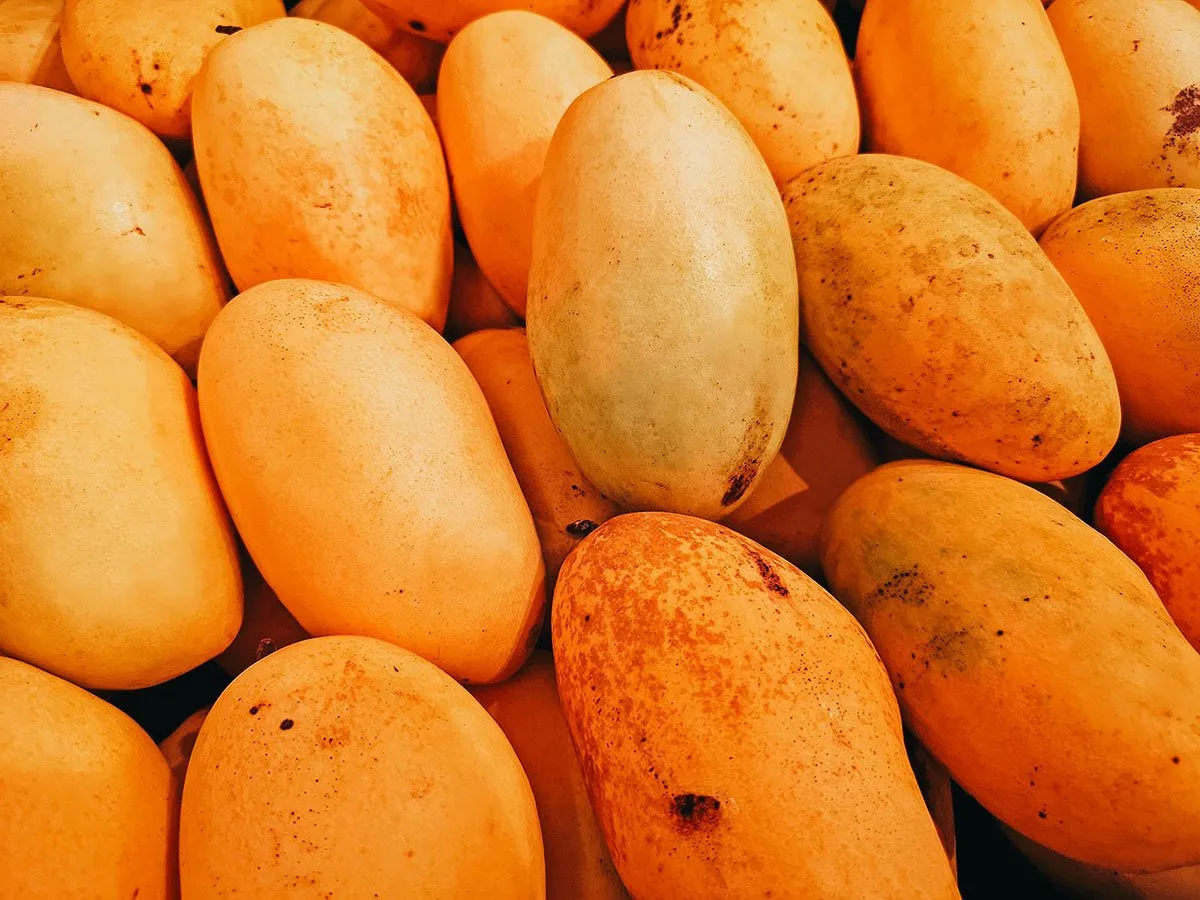
Philippine mangoes are delicious when golden but they’re just as popular when they’re still green and unripe. Unripe green mangoes are often paired with a fermented shrimp paste called bagoong. It’s a popular snack and Filipino street food dish that can be found pretty much anywhere in the country.
But be warned, bagoong is an acquired taste. It’s extremely pungent but if you can get past its smell and funky flavor, then you’ll be rewarded with an intriguing balance of sweet, sour, salty, crunchy, and juicy.
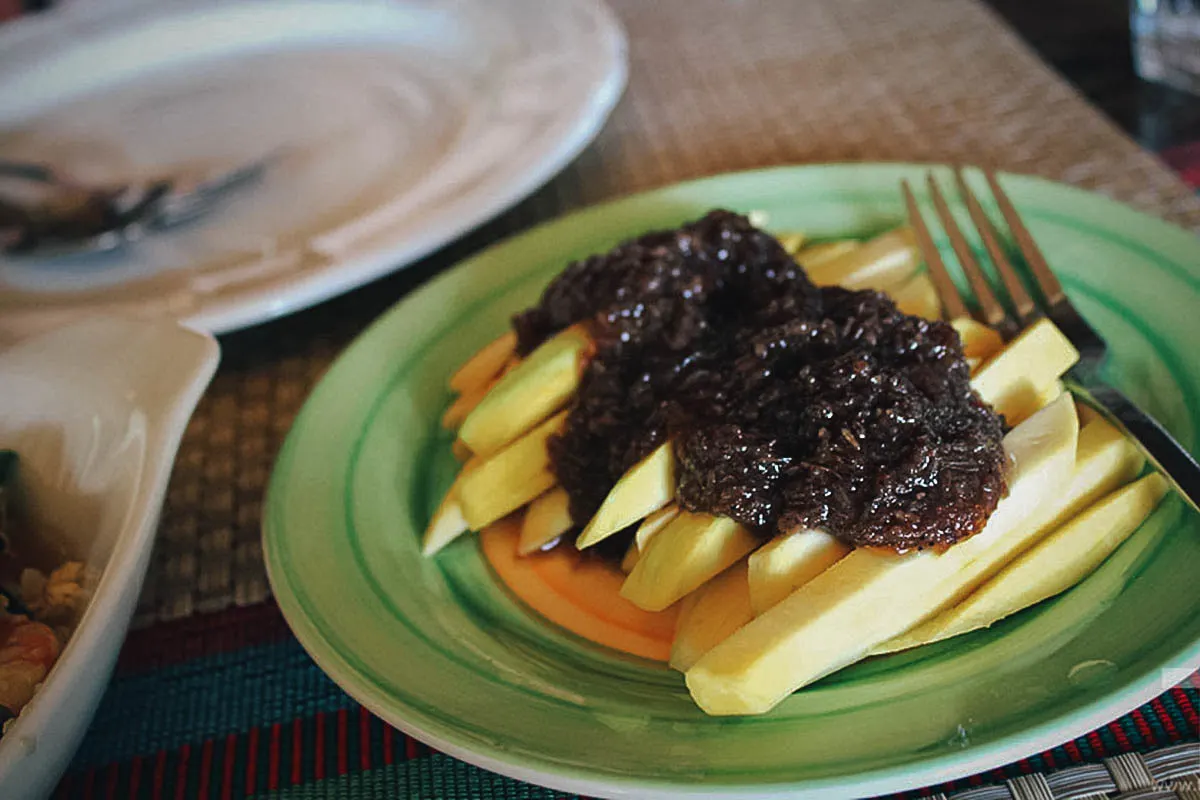
2013 Angeles Philippines Trip Day 5 by tofuprod, used under CC BY-SA 2.0 / Processed in Photoshop and Lightroom
2. Custard Apple
Like mangoes, the custard apple or sugar apple is one of my favorite Filipino fruits. Known locally as atis, this exotic fruit with knobby green skin and white fruit flesh will remind you of a creamy custard when fully ripe.
This funky-looking green fruit may seem intimidating at first with its dozens of fleshy white segments but it’s actually quite easy and fun to eat. You break it in half with your hands and take spoonfuls of the fleshy segments in your mouth. Each will have a seed that separates easily from its creamy white flesh, which you can then spit out one by one.
Scientific name: Annona squamosa
Filipino name: Atis
Custard apple season in the Philippines: September to December
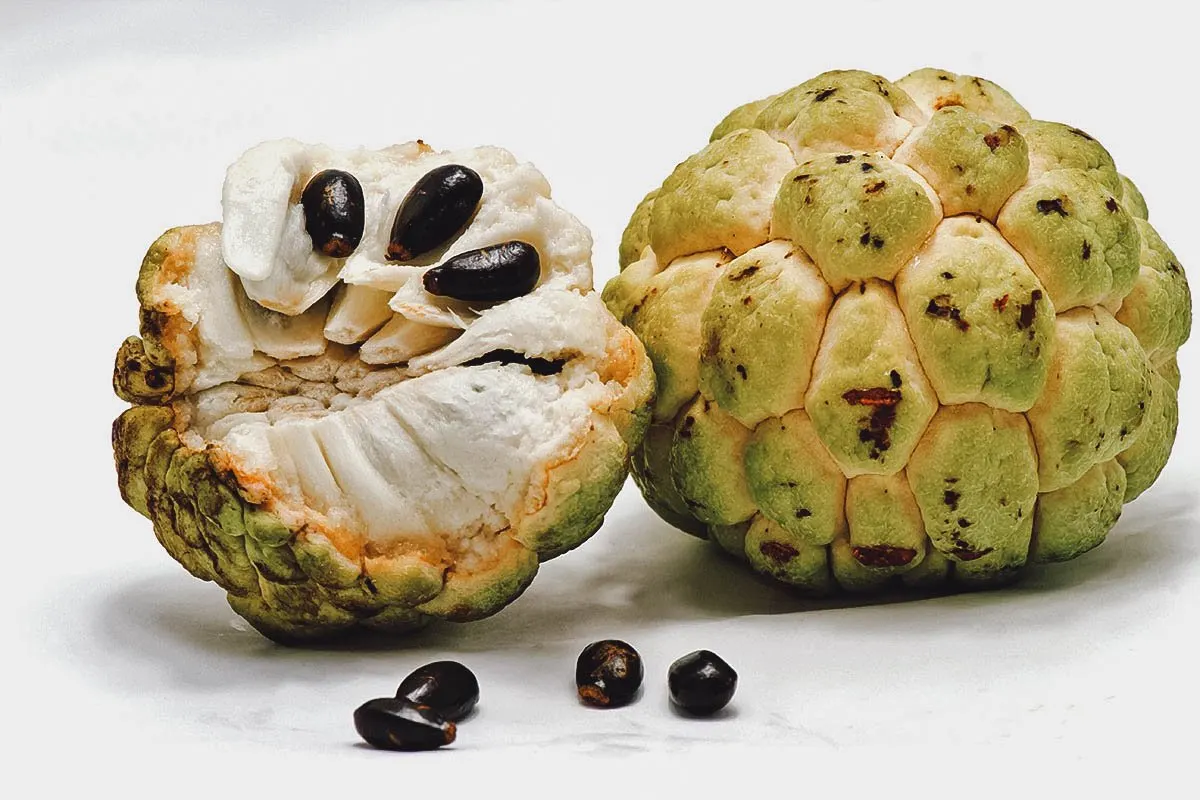
Photo by maturos1812
3. Muntingia
I only recently learned the English name of this fruit because I’ve always known it by its Filipino name – aratilis. Known in English as muntingia or Jamaican cherries, they’re native to the neotropics from Mexico to Bolivia. They’re small – about the size of cherry eggplants – and start off green before turning bright red when fully ripe.
Unlike many of the fruits you’ll find in the Philippines, aratilis isn’t something you’d typically find at local markets. Instead, it’s a type of fruit that grows on trees in people’s backyards or on vacant lots. We didn’t have an aratilis tree growing up so it was always something I craved for as a child. Very rarely did markets sell them so I’d be ecstatic the few times my mother would chance upon them.
Aratilis have thin skin and a soft juicy pulp that bursts in your mouth when you bite into it. It has a unique sweet taste and texture that I still find irresistible to this day.
Scientific name: Muntingia calabura
Filipino name: Aratilis
Muntingia season in the Philippines: March to June
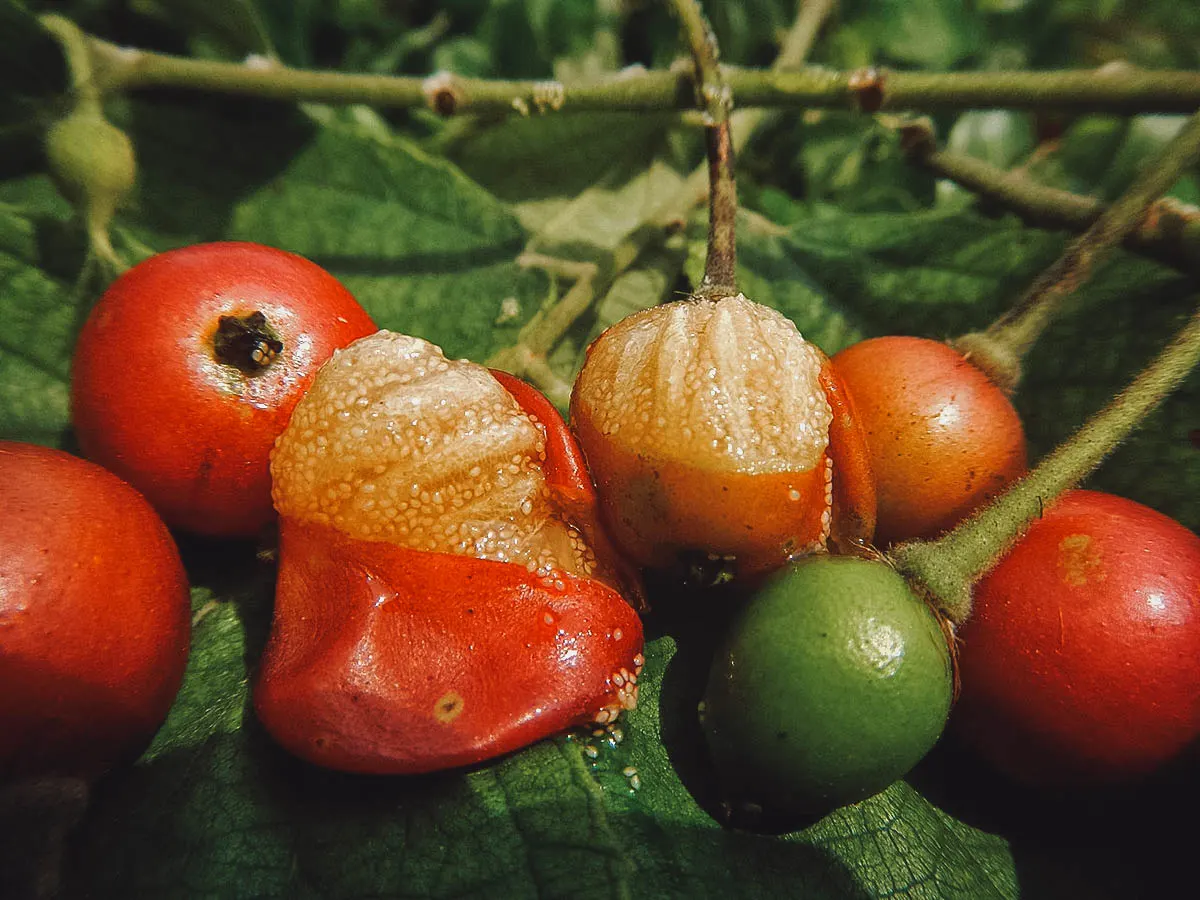
Judgefloro, CC0, via Wikimedia Commons / Processed in Photoshop and Lightroom
4. Soursop
Soursop is an exotic fruit native to the Americas and the Carribean. It’s also common in parts of South East Asia like the Philippines where it’s known as guyabano. This prickly, elongated green fruit has a slightly acidic and citrusy taste when ripe, and a thick creamy texture similar to banana.
Guyabano can be eaten ripe in the Philippines but it’s often made into fresh fruit juices, shakes, candies, jams, and ice creams.
Scientific name: Annona muricata
Filipino name: Guyabano
Soursop season in the Philippines: August to November
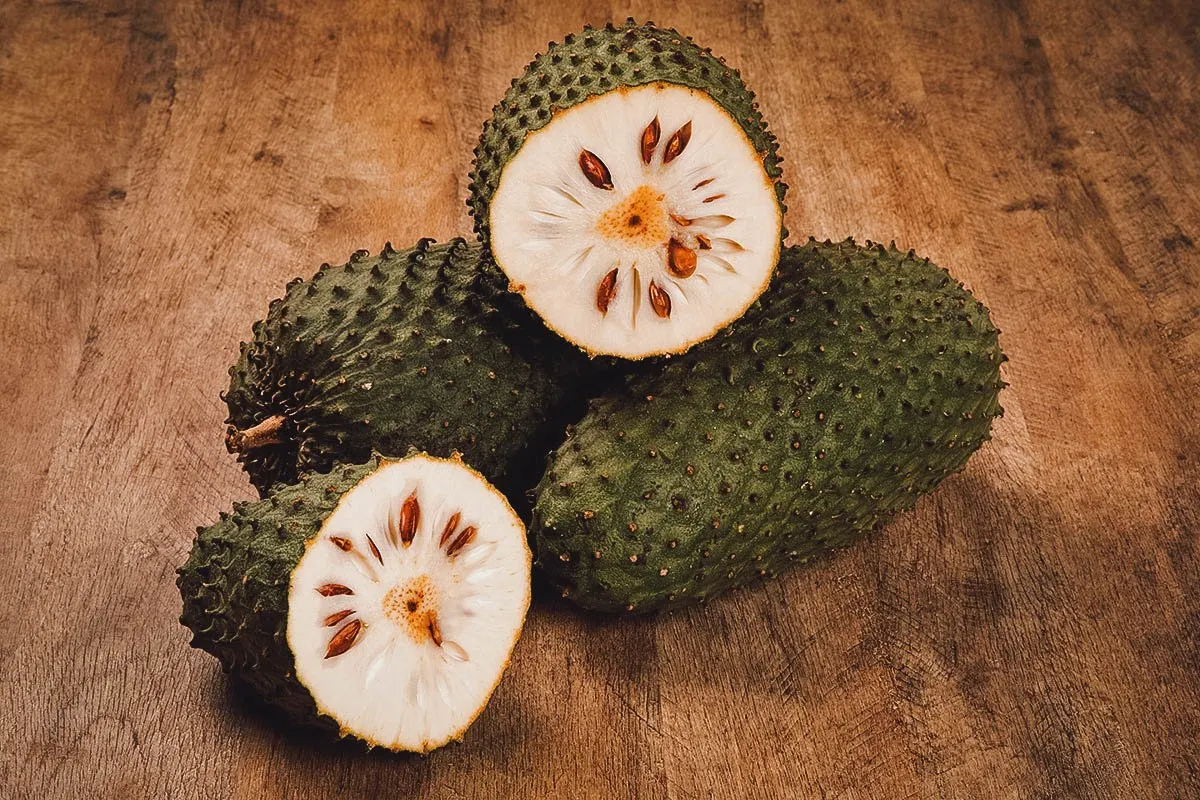
Photo by Paulovilela
5. Star Fruit
The English name for this next Filipino fruit doesn’t really make sense at first until you slice it. Known locally as balimbing, this distinctively-shaped exotic fruit with five ridges resembles small yellow-orange stars when sliced across.
Balimbing is rich in vitamin C and antioxidants and is often dubbed as a superfruit. Each star fruit contains up to 22 grams of vitamin C and is rich in dietary fiber, magnesium, potassium, and folic acid. It’s said to strengthen the immune system and is a good natural treatment for various ailments like the common cold and diabetes.
It’s interesting to point out that Filipino politicians with fleeting allegiances are often called balimbing. When used in this context, it loosely translates to “two-faced” and is in reference to the fruit’s many facets.
Scientific name: Averrhoa carambola
Filipino name: Balimbing
Star fruit season in the Philippines: May to August
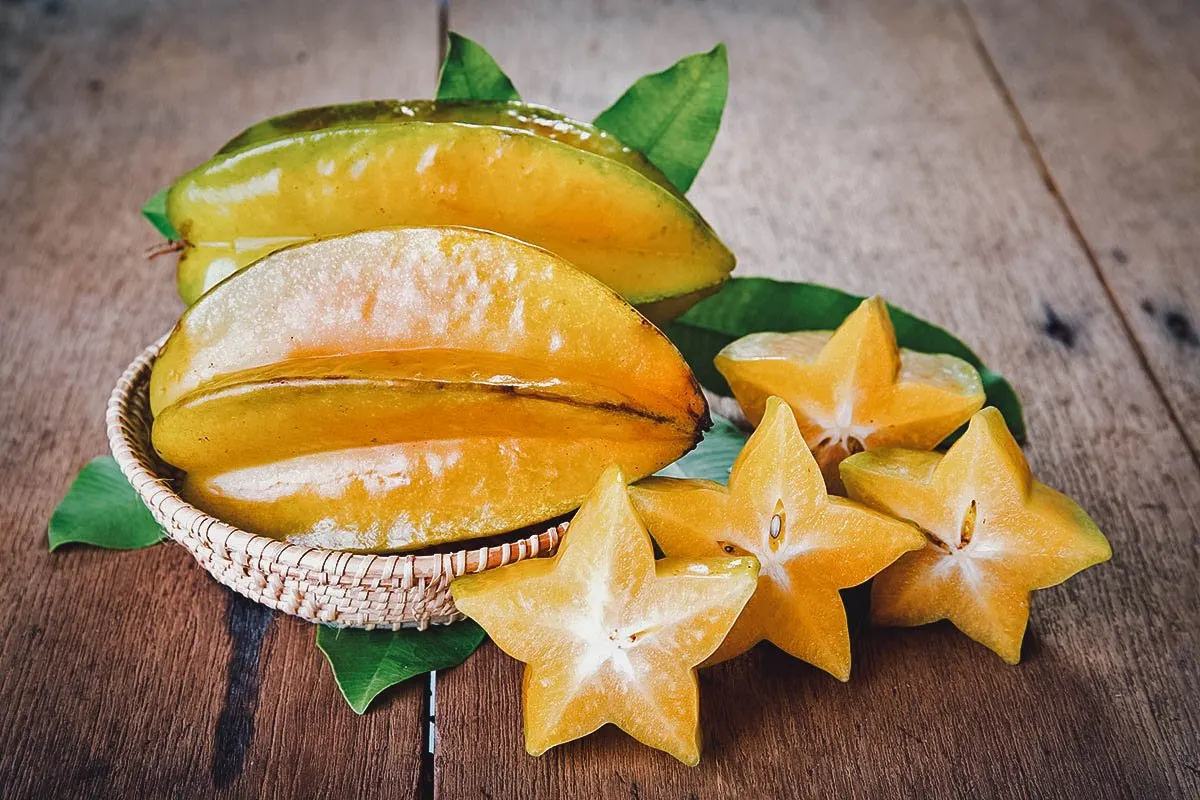
Photo by sirikornt
6. Pineapple
The pineapple is one of the most well-known and beloved tropical fruits in the world. Known locally as pinya, it’s one of the most common fruits in the Philippines. In 2016, the Philippines, Costa Rica, and Brazil accounted for about one-third of the world’s total pineapple production.
Pineapples are rich in vitamin C and manganese. It’s often eaten fresh or canned in the Philippines, but thanks to its sweet and sour taste, it’s commonly used as an ingredient in Filipino dishes like pininyahang manok and chicken afritada.
As previously described, pineapples play an important role in Filipino culture. Their long leaves are woven into piña fibers which are then used to make traditional clothing like barong tagalog, baro’t saya, and traje de mestiza.
Scientific name: Ananas comosus
Filipino name: Pinya
Pineapple season in the Philippines: May to July
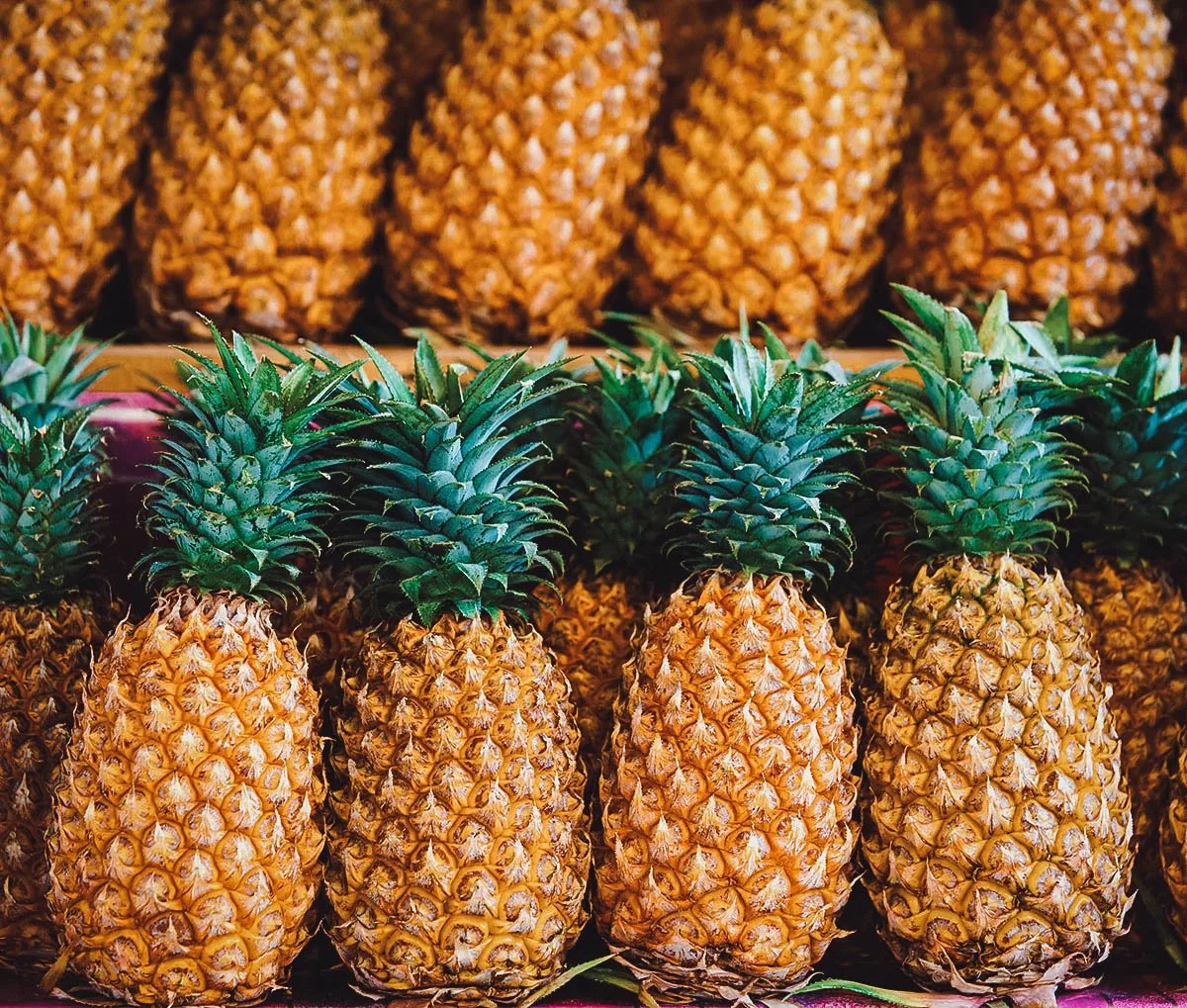
Photo by ewastudio
7. Sapodilla
Sapodilla or chico is a brown oval-shaped fruit cultivated in parts of Latin America, South Asia, and Southeast Asia. Like balimbing, it’s regarded as a high-energy fruit teeming with antioxidants and minerals like iron, calcium, magnesium, potassium, and phosphorus. It’s also said to be rich in vitamin C and vitamin B complex.
Chico looks more like a potato than fruit but it does have a soft and juicy pulp with a malty and sweet taste. Its texture is similar to a pear – slightly gritty but not unpleasant.
Scientific name: Manilkara zapota
Filipino name: Chico
Sapodilla season in the Philippines: January and February
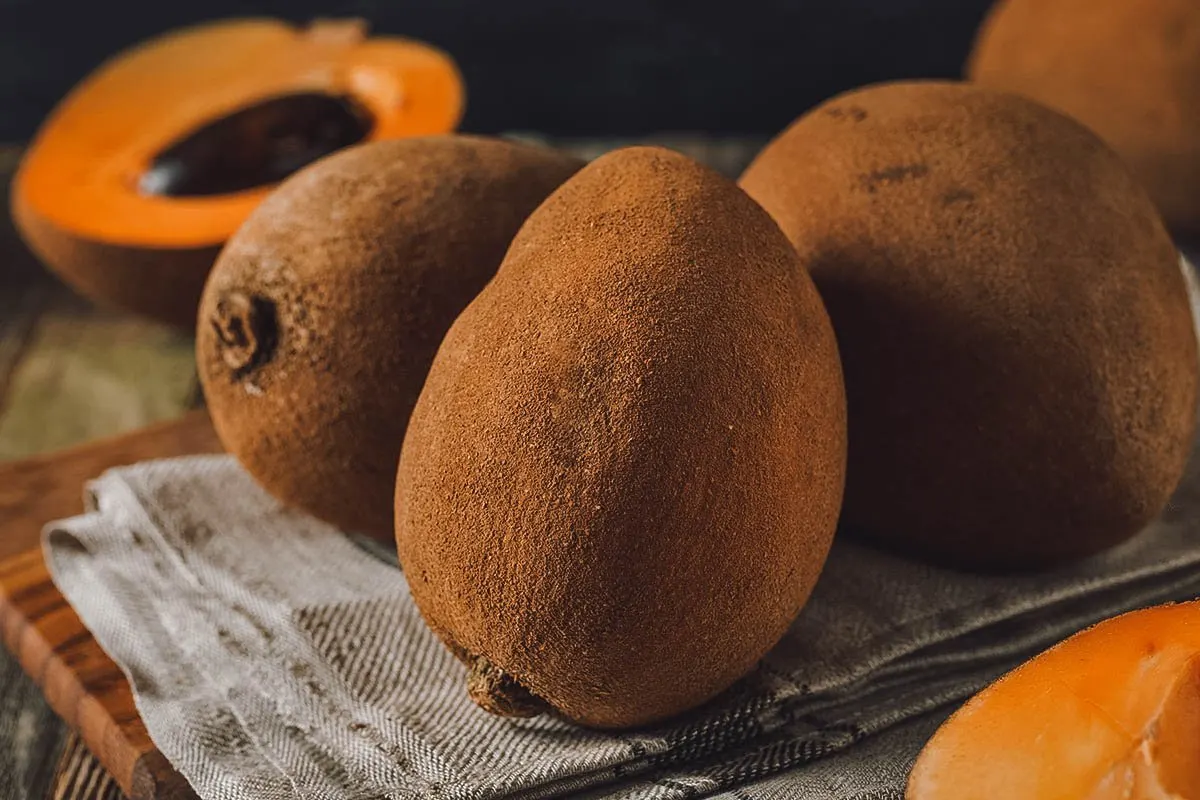
Photo by bhofack2
8. Cotton Fruit
Cotton fruit or santol is a tropical fruit native to Malesia. Round in shape and about the size of an apple, it contains five or six seeds covered in soft white flesh that can range in flavor from sour to sweet, depending on the maturity of the fruit.
Santol gets its English name from the soft and juicy but cotton-like consistency of its flesh that can be difficult to separate from the seeds.
Scientific name: Sandoricum koetjape
Filipino name: Santol
Santol season in the Philippines: July to September
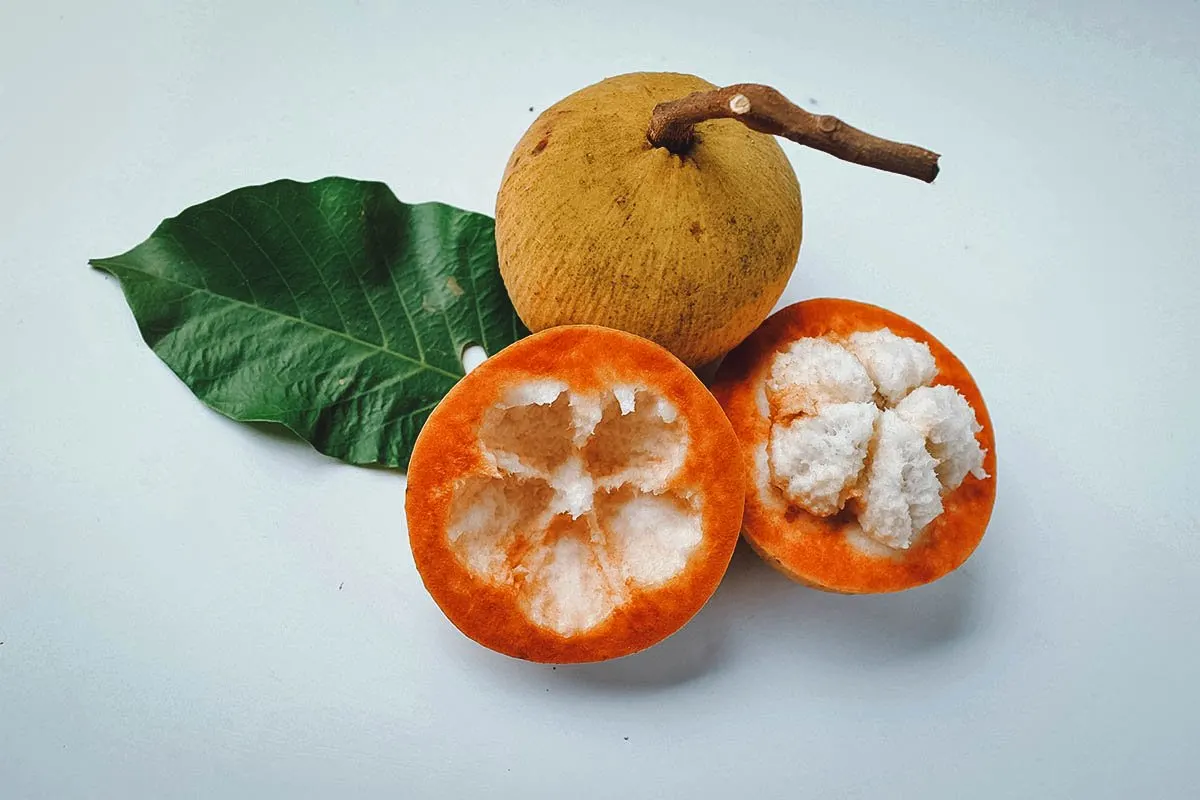
Photo by NantawanPatamarot
9. Guava
The guava is a round green fruit with white flesh and many small seeds. Known locally as bayabas, it can range in flavor from sour to sweet and is said to be rich in vitamin C and vitamin A.
We had a bayabas tree in our backyard growing up but I never really took to it. It can be eaten raw but I much prefer it when it’s processed into candies or jams. When ripe, it can also be used as an ingredient in Filipino dishes like sinigang.
Scientific name: Psidium guajava
Filipino name: Bayabas
Guava season in the Philippines: September to December
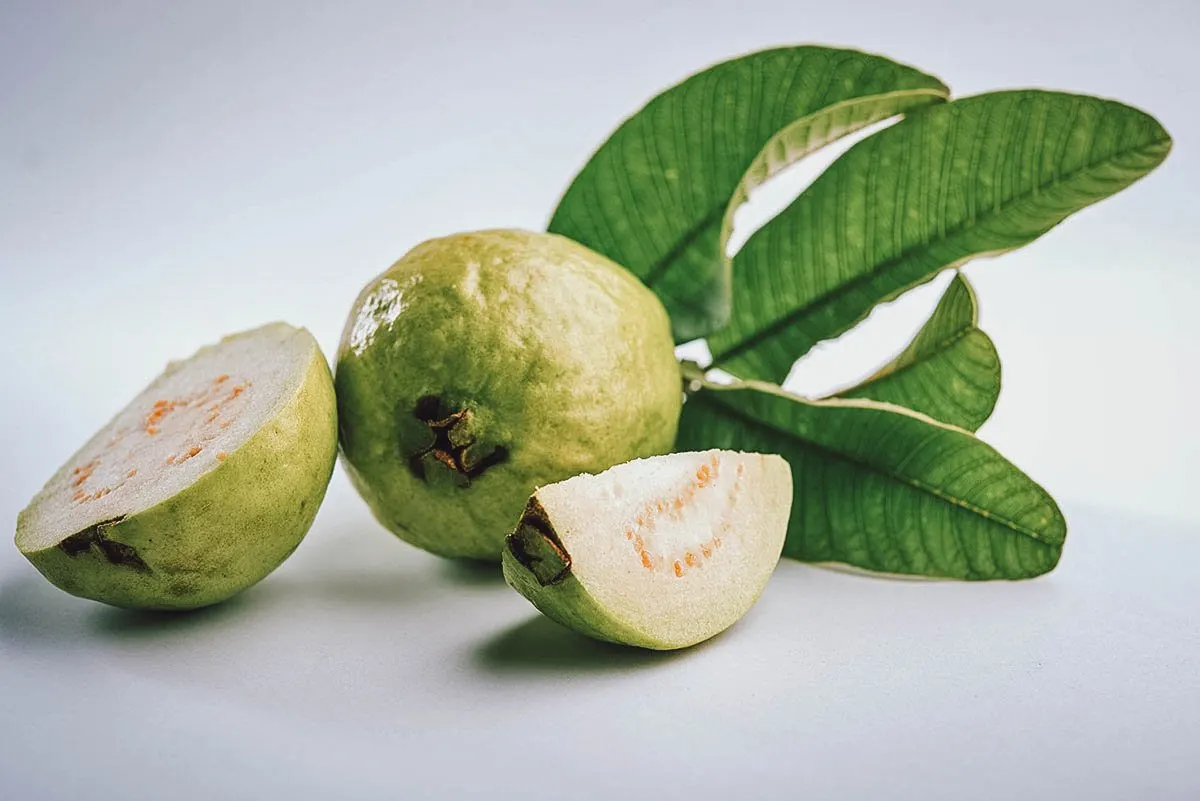
Photo by stockimagefactory.com
10. Watermelon
Like many parts of the world, watermelon is considered the ultimate summer fruit in the Philippines. Known locally as pakwan, one wedge of this incredibly juicy fruit is all you need to quench your thirst in a hot tropical country like the Philippines.
Unlike American watermelons that are oval-shaped, watermelons in the Philippines are almost perfectly round and a much darker shade of green. When fully ripe, the flesh is sweet, juicy, and incredibly satisfying.
Scientific name: Citrullus lanatus
Filipino name: Pakwan
Watermelon season in the Philippines: March to July
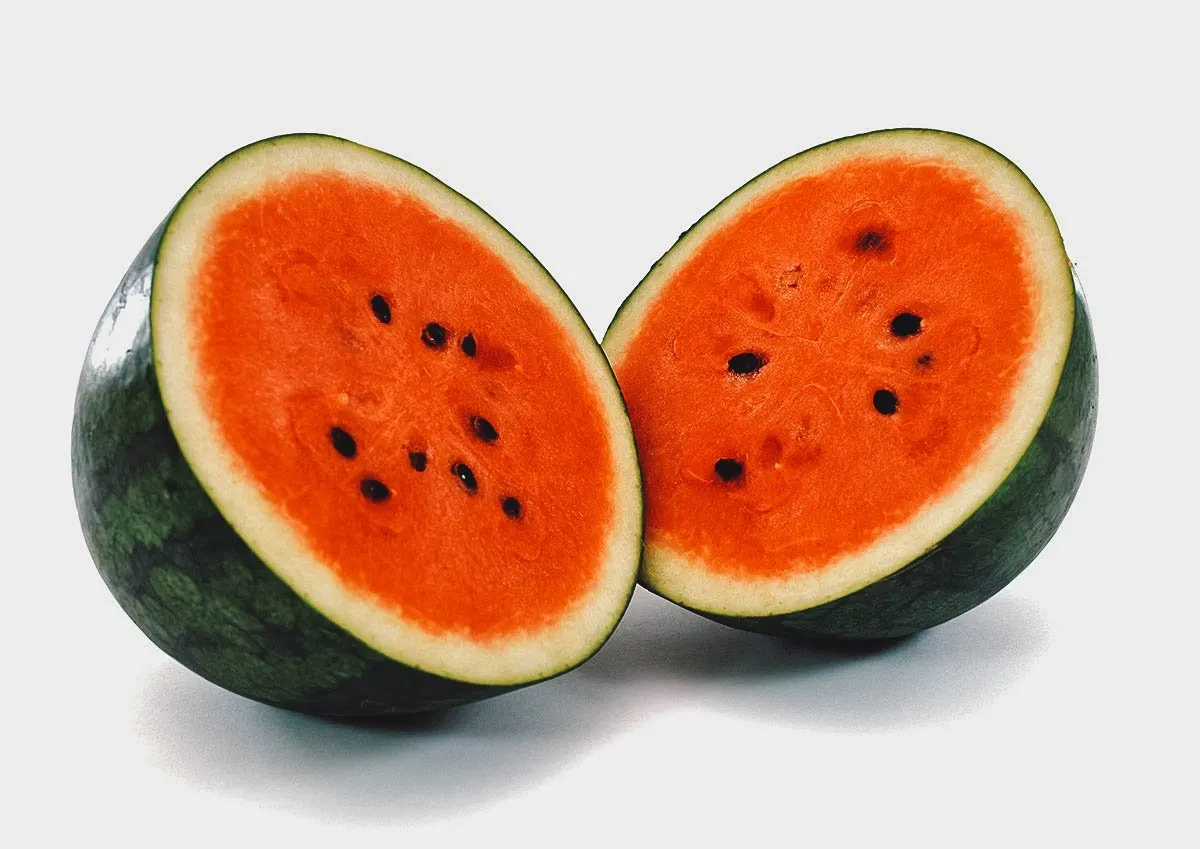
Photo by book_jade
11. Cantaloupe
Like watermelon and pineapple, the cantaloupe or melon needs little introduction. It’s a popular fruit in many parts of the world, including the Philippines, where it’s beloved for its sweet and juicy, honey-like flesh.
In the Philippines, melon is typically eaten fresh or shredded into a refreshing drink with water, sugar, milk, and ice. Like fresh coconut juice, it’s a popular Filipino drink served in plastic bags with a straw.
Scientific name: Cucumis melo var. cantalupensis
Filipino name: Melon
Cantaloupe season in the Philippines: April to July
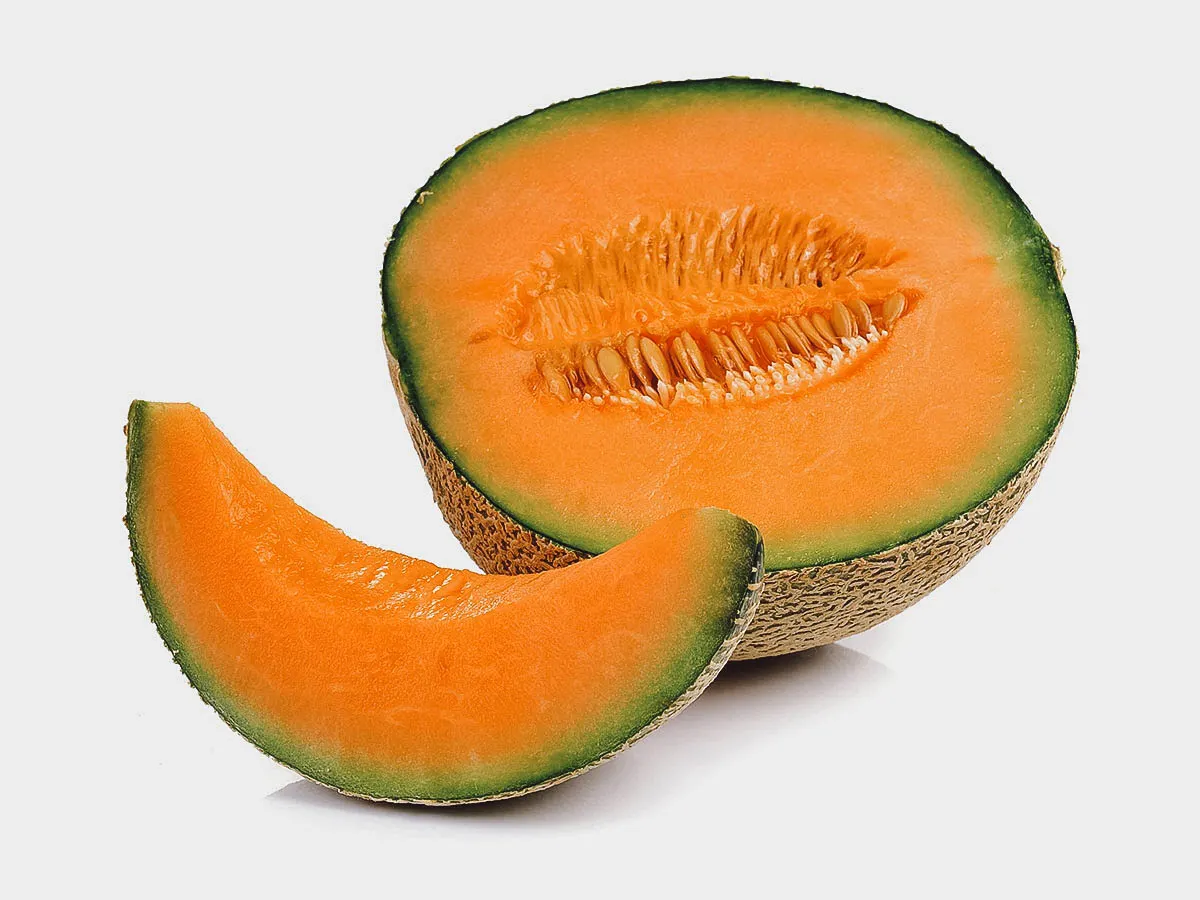
Photo by sommaill
12. Banana / Plantain
Bananas are among the most popular fruits you’ll find in the Philippines. In fact, the Philippines is the second-largest exporter of bananas in the world, behind only Ecuador. They’re harvested all year round and come in dozens of varieties, some of the most popular being Lacatan, Latundan, Bungulan, and Saba.
Scientific name: Musa sapientuma
Filipino name: Saging
Banana season in the Philippines: Year-round
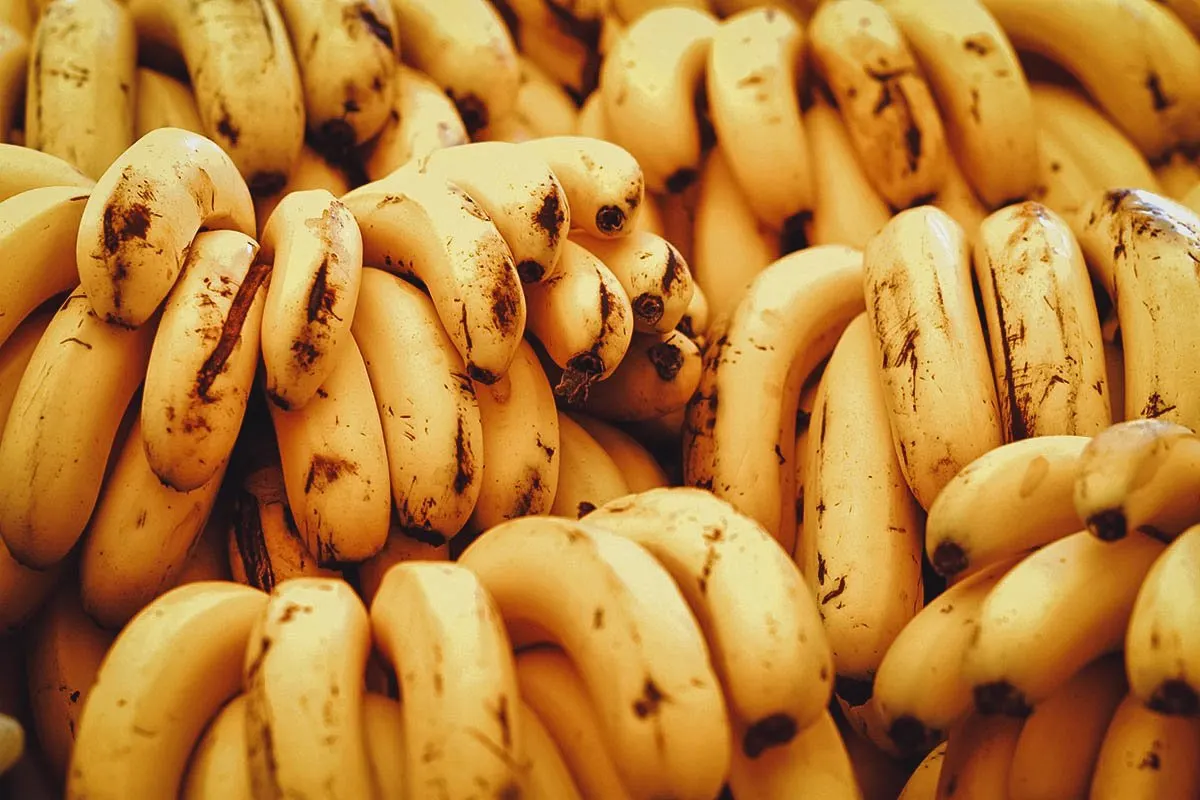
Photo by PantherMediaSeller
One of the most popular types of bananas in the Philippines is saging na saba, or simply saba for short. It’s a type of sweet plantain that’s used mainly as a cooking banana, though it can also be eaten raw when fully ripe.
Because of its role in Filipino cuisine, many Filipinos consider saba to be the most important type of banana in the Philippines. It’s used as an ingredient in Filipino desserts like banana cue or turon, as well as in meat dishes like pochero or arroz a la cubana. It’s also the key ingredient in Filipino banana ketchup.
Scientific name: Musa acuminata × balbisiana
Filipino name: Saging na saba
Plantain season in the Philippines: Year-round
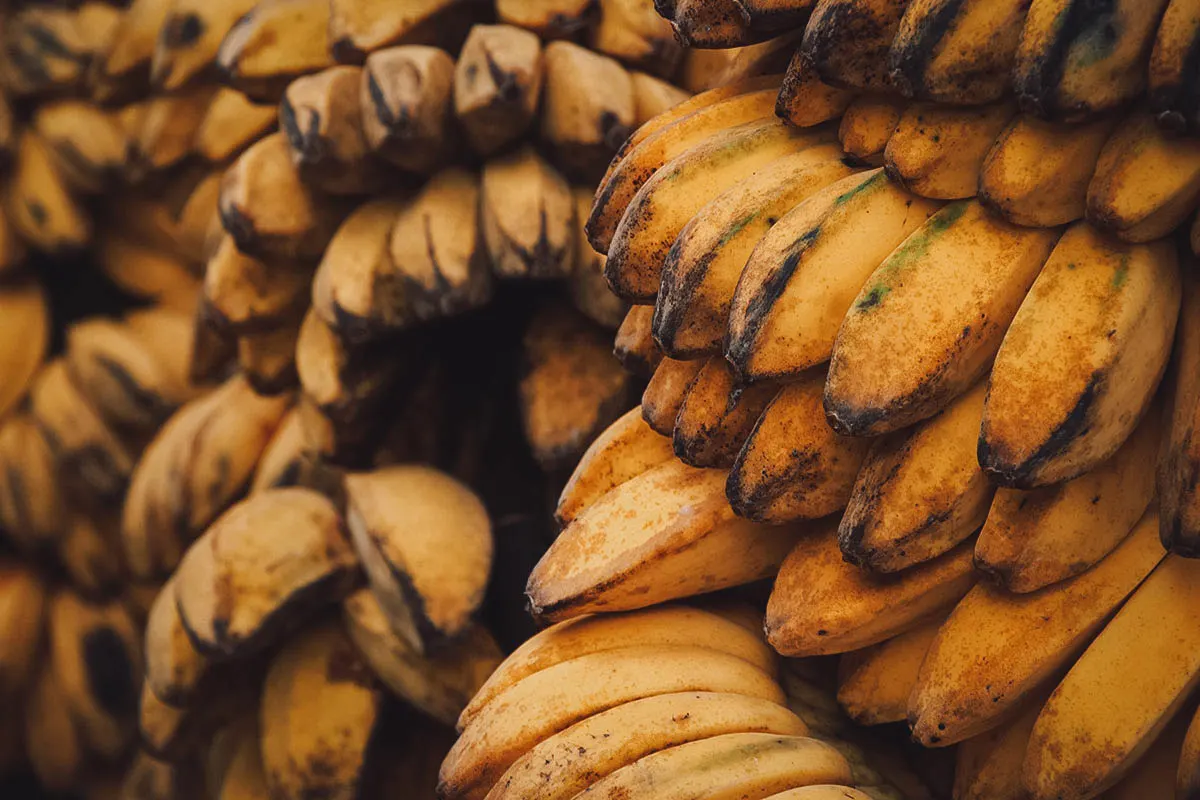
Photo by ngarare
13. Longan
Longan is a delicious fruit native to China and tropical Asia. It has thin, pale brown skin that you break apart to get to the juicy sweet flesh inside. To eat, you pop the whole thing in your mouth and eat the fruit before spitting out the seed.
Longan is very similar to lychee and rambutan but in my opinion, it’s the best of the three. It has a nectar-like sweet flavor and is the easiest of the three to separate from the seed.
Scientific name: Dimocarpus longan
Filipino name: Longan
Longan season in the Philippines: August to October
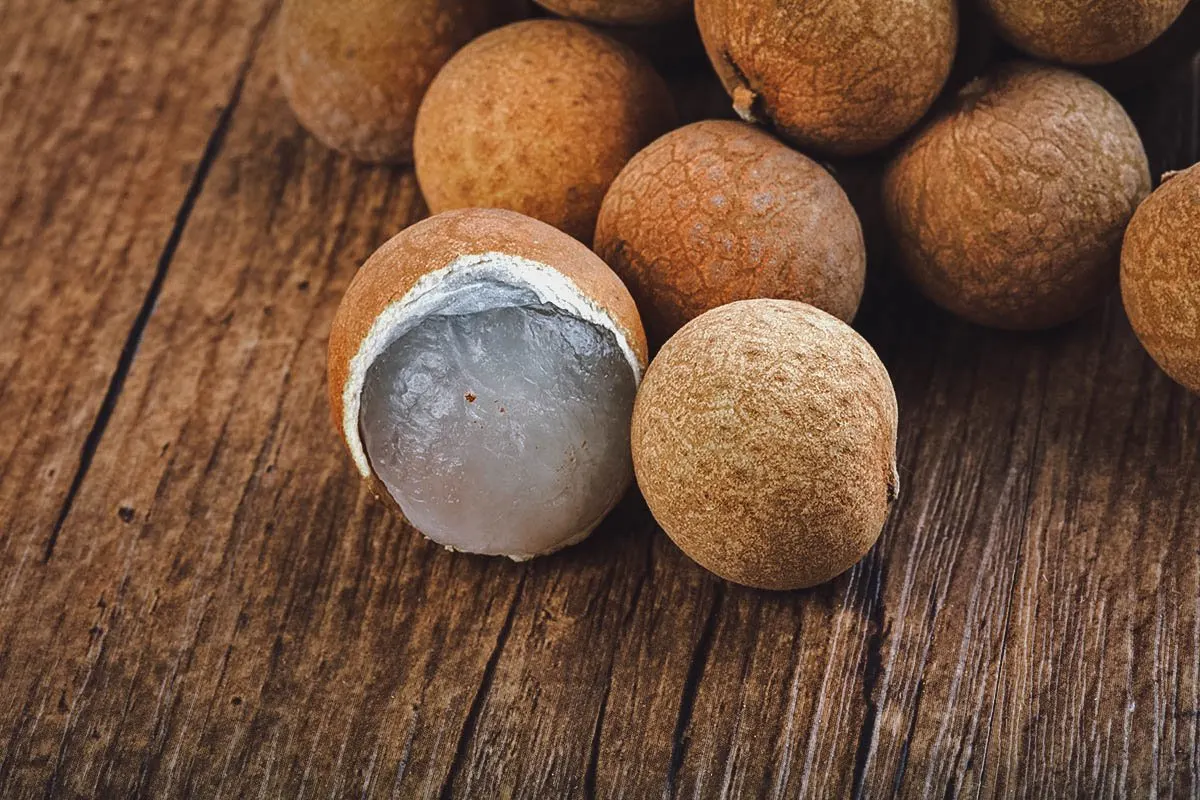
Photo by AndreySt
14. Lychee
As described, lychee is very similar to longan and rambutan. This red fruit with the rough skin falls somewhere between the two other fruits in terms of sweetness and ease of eating. For me, it isn’t quite as sweet as longan and the flesh can sometimes be more difficult to strip from the seed.
In the Philippines, lychee is commonly eaten as is though it’s common to see it in canned, deseeded versions as well. Submerged in syrup, canned lychees are often used as an ingredient in Filipino desserts like gulaman or buko fruit salad.
Scientific name: Litchi chinensis
Filipino name: Litsiyas
Lychee season in the Philippines: May to August
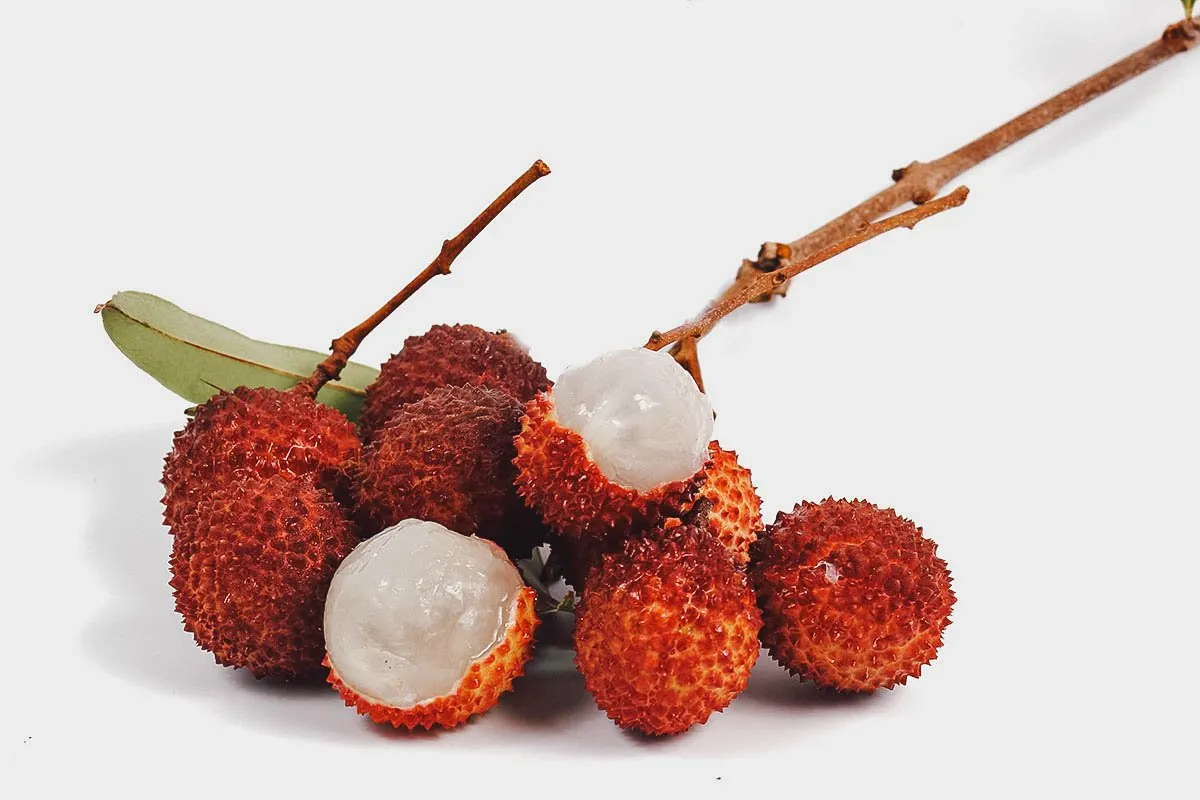
Photo by kung_mangkorn
15. Rambutan
Rambutan is much more interesting to look at than longan or lychee but unfortunately, it typically isn’t as sweet as the other two and is harder to eat. This exotic fruit has a thicker rind that you sometimes have to cut open with a knife, and the flesh is often harder to strip from the seed even when it’s fully ripe.
Rambutan is a red fruit known for its many hair-like protrusions. Its name is derived from the Malay word rambut, meaning “hair”.
Scientific name: Nephelium lappaceum
Filipino name: Rambutan
Rambutan season in the Philippines: August to October
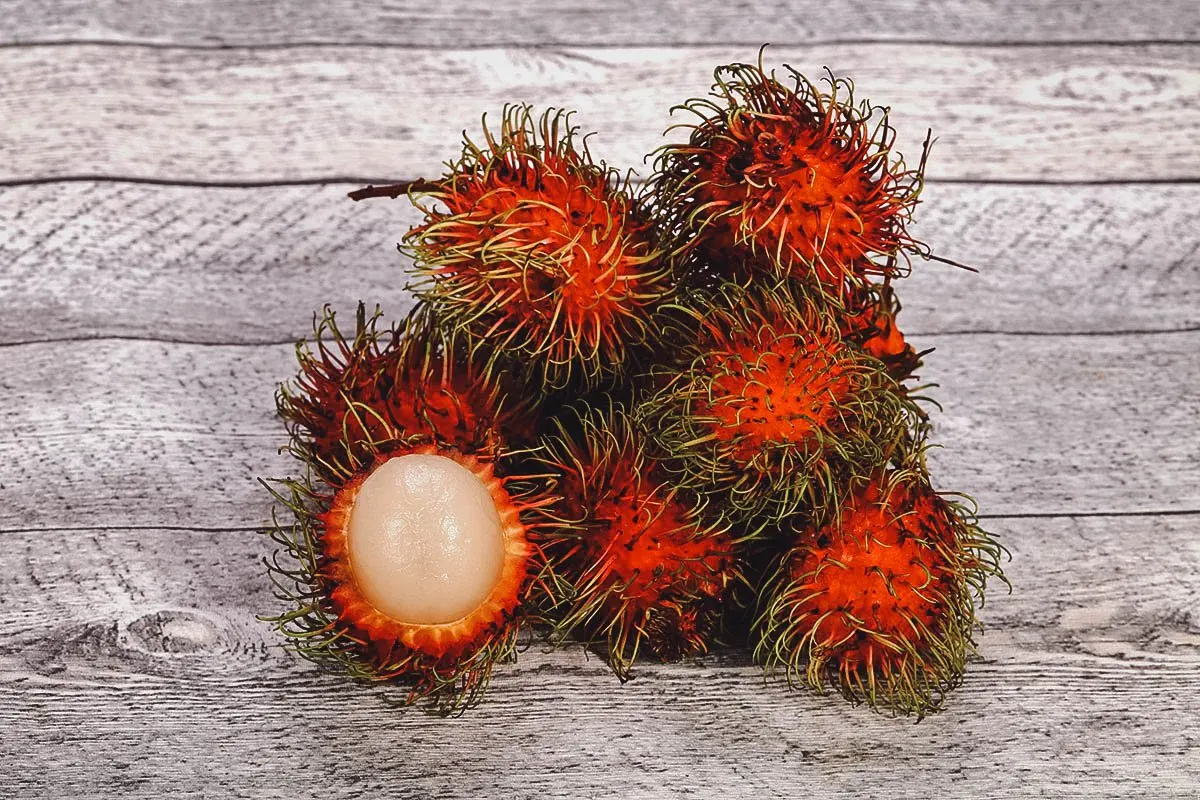
Photo by AndreySt
16. Calamondin
Like saging na saba, calamondin or calamansi is one of the most important fruits in Filipino cooking. Many Filipino recipes are made even more delicious by this small sour fruit often referred to as the Philippine lemon.
About the same diameter as a bottle cap, calamansi is a small citrus fruit native to the Philippines and parts of East and South East Asia. Rich in vitamin C, it’s naturally very sour and used to impart a punch of acidity to sauces, drinks, dishes, and marinades.
Calamansi is often served whole with many Filipino dishes, to be spritzed over the dish or mixed into a dipping sauce with chili, soy sauce, vinegar, or fish sauce.
Scientific name: x Citrofortunella microcarpa
Filipino name: Calamansi
Calamondin season in the Philippines: August to October
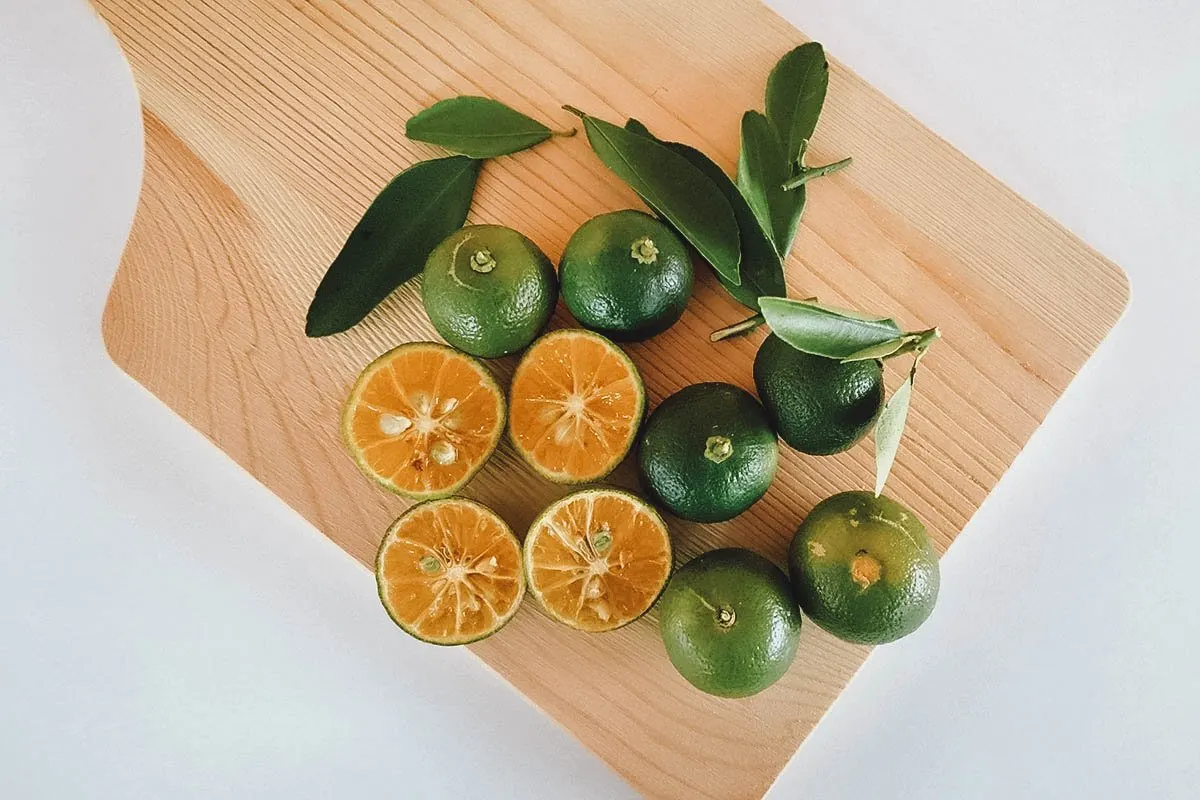
Photo by mdbakrih.gmail.com
17. Lanzones
When it’s fully ripe and from the right region, lanzones is one of my favorite Filipino fruits. It refers to a popular Southeast Asian fruit with thin, light brown skin and translucent flesh.
Clustered together like grapes, you break open the skin of lanzones to reveal a fleshy fruit with four or five segments. The largest segments will have a seed in the middle. To eat, you put one segment in your mouth at a time and eat around the seed before spitting it out. Be careful not to bite into the seed because it can often have a very bitter taste.
The sweetness of lanzones fruit can vary greatly depending on where it’s from. Average or not fully ripe lanzones will be sour and sweet but the best lanzones, from Camiguin Island, will have a nectar-like sweetness that’s unlike any other lanzones in the Philippines.
Camiguin lanzones are so famous that they have their own festival celebrated on the third weekend of October every year.
Scientific name: Lansium domesticum
Filipino name: Lansones
Lanzones season in the Philippines: August to December
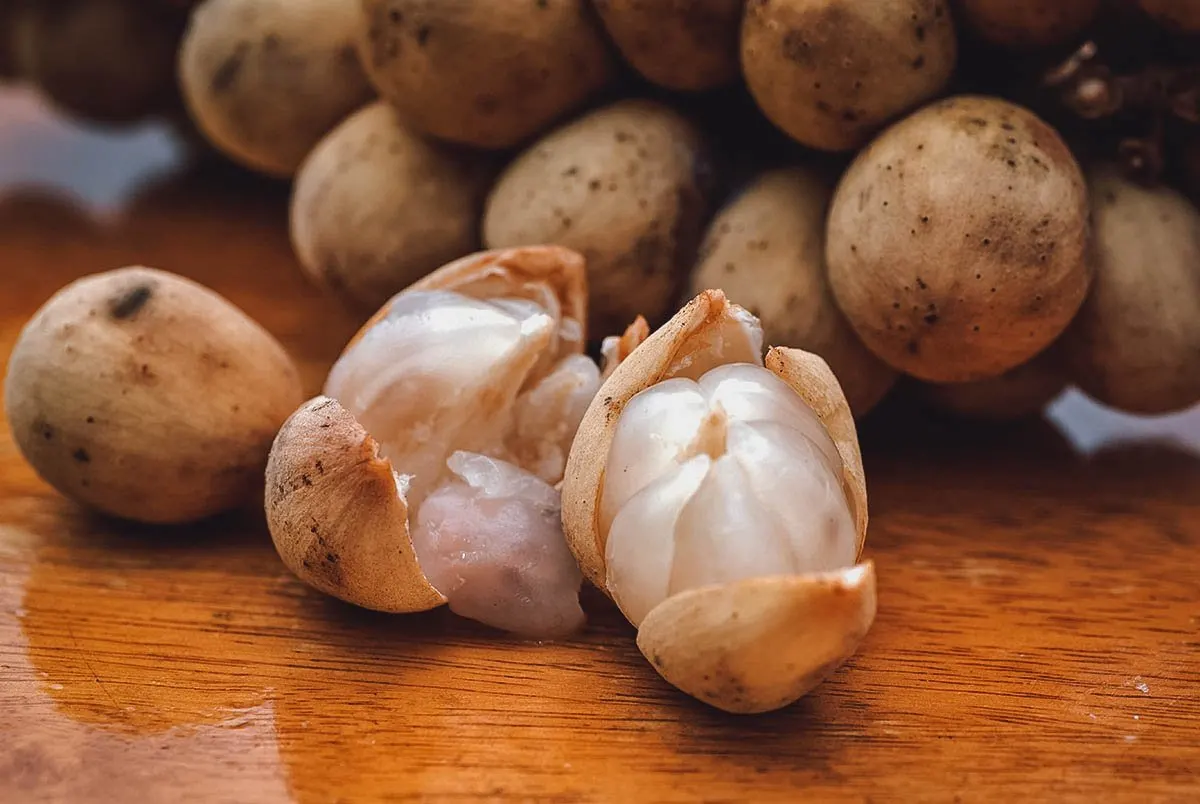
Photo by sweemingyoung
18. Durian
Durian may not be as celebrated in the Philippines as it is in other Southeast Asian countries, but it’s still worth trying if you go to the right region. Durian can grow throughout the Philippines but the best varieties come from Mindanao, specifically Davao.
When Filipinos think of durian in the Philippines, they think of Davao. The city of Davao is forever intertwined with this exotic fruit much in the same way that Guimaras is associated with the best mangoes and Camiguin is home to the best lanzones.
Durian’s reputation precedes itself but if you aren’t so familiar with this strange-looking tropical fruit, it’s known for its thorny rind and unrelenting stench that’s been likened to rotting flesh. However, get past the smell and you’ll be rewarded with a soft and indescribably delicious fruit reminiscent of custard flavored with almonds.
Like that polarizing and weird Filipino dish called balut, people either love or hate durian. Personally, I love it.
Scientific name: Durio zibethinus
Filipino name: Durian
Durian season in the Philippines: August to October
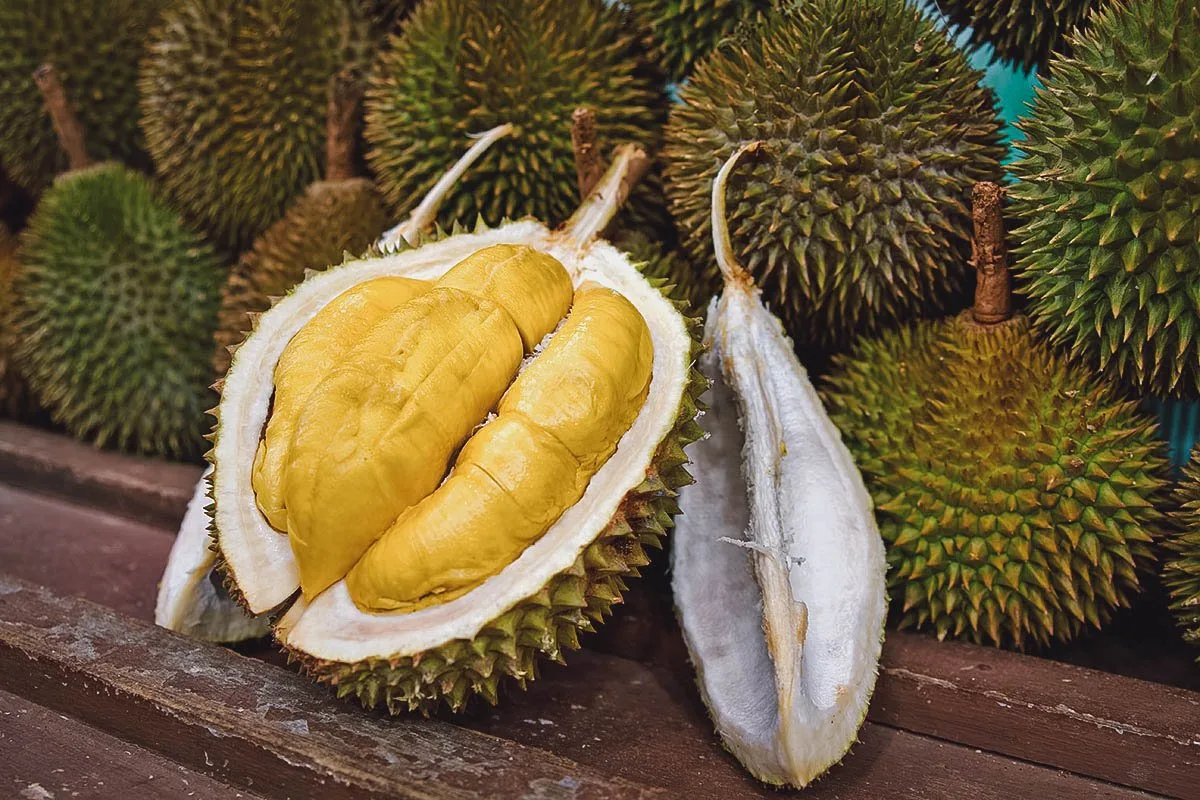
Photo by davidgn
19. Coconut
Coconuts are everywhere in the Philippines. You’ll see coconut trees along the beach, on the side of the road, on empty lots, and in people’s backyards. Coconut is one of the most important crops in the Philippines and a vital part of the local culture and cuisine.
Known locally as buko, coconut juice can be enjoyed fresh as a drink while the flesh can be eaten raw. However, it can also be processed into useful ingredients like coconut cream, coconut milk, desiccated coconut, and coconut oil. Many Filipino desserts are made with coconut, either as the main ingredient or as a condiment or topping. It’s also made into various food products like candies, ice creams, and jams.
Aside from food, the fruit and other parts of the coconut tree can be used to make a range of products like walis tingting (coconut midrib broom), floor polishers, utensils, and handicrafts. When it comes to usefulness and versatility, the coconut is without peer.
Scientific name: Cocos nucifera
Filipino name: Buko
Coconut season in the Philippines: Year-round
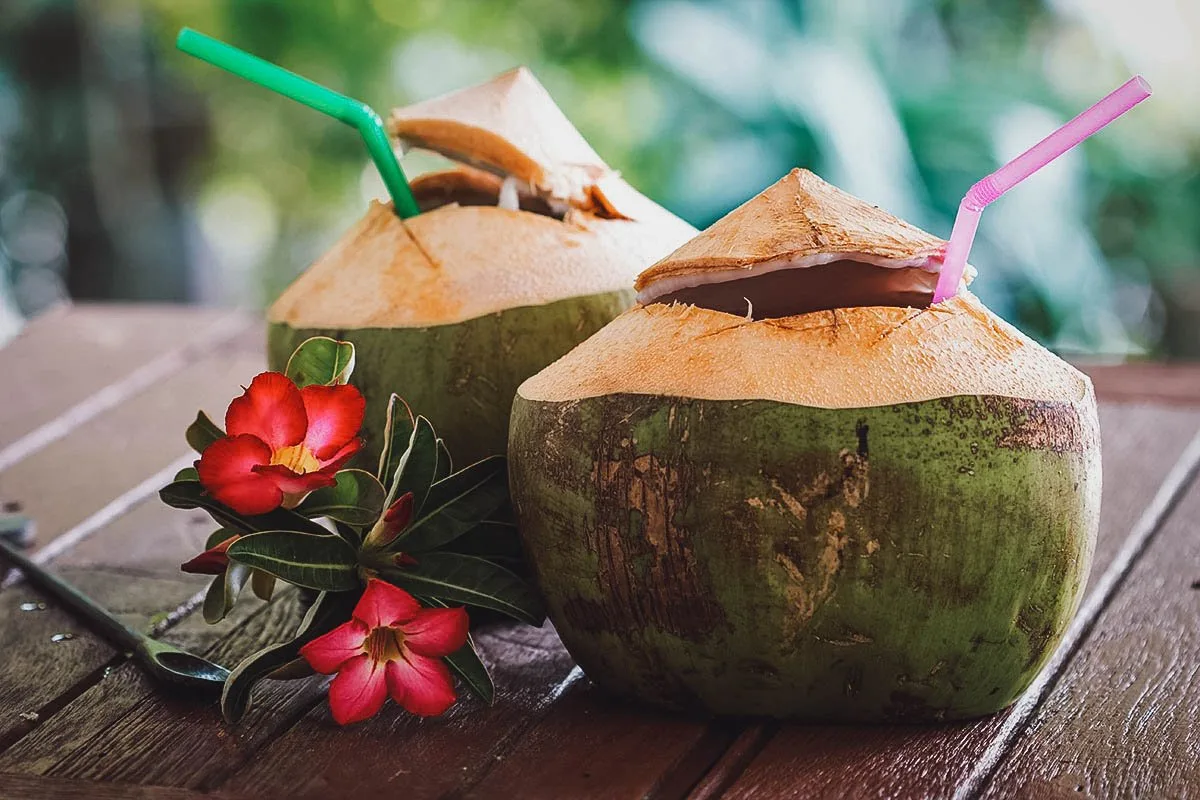
Photo by tiverylucky
20. Java Plum
The java plum is a tropical fruit that goes by many names like black plum, malabar plum, jamun, and jambolan. In the Philippines, we refer to it as duhat. It’s about the size and shape of a grape and starts out green before ripening into a deep violet, almost black color.
Rich in vitamin C, duhat has a sour-sweet taste and an astringent flavor that causes a puckering sensation in your mouth. It’ll stain your tongue and your clothes purple so be careful when you eat it.
Scientific name: Syzygium cumini
Filipino name: Duhat
Java plum season in the Philippines: March to July
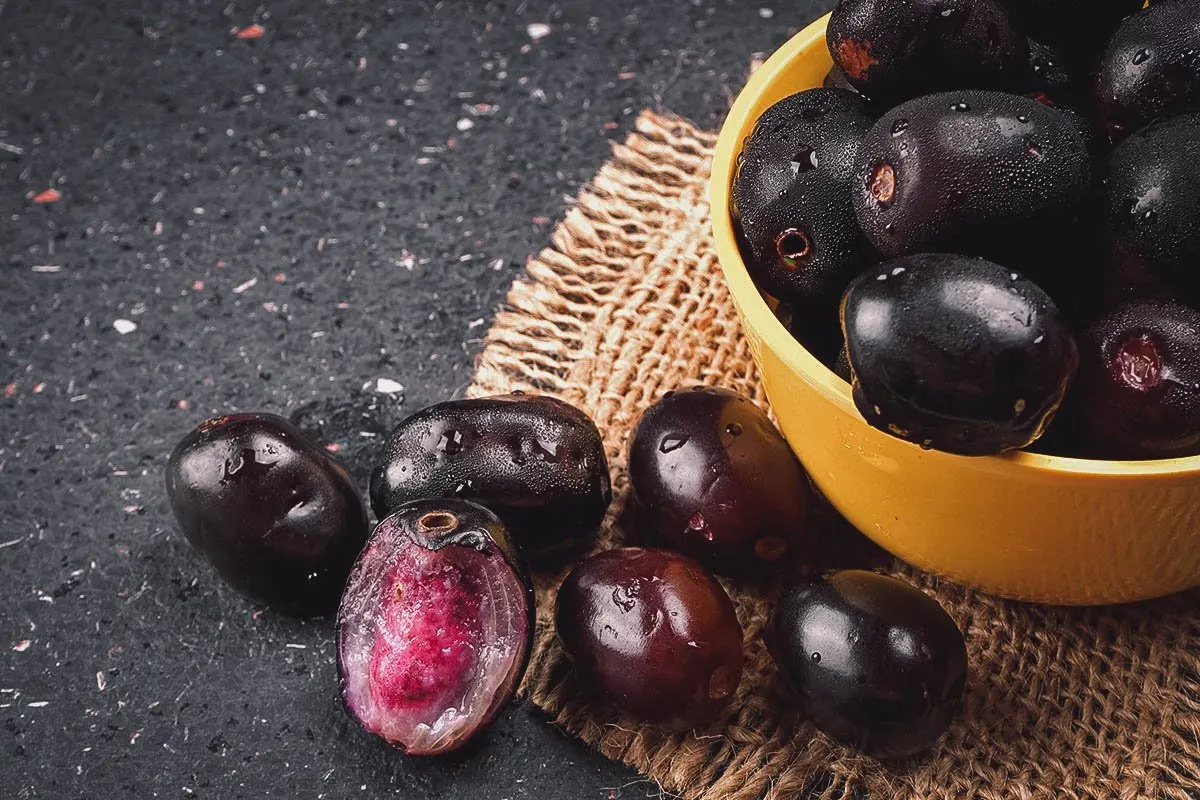
Photo by rakshashelare
21. Wax Apple
Like duhat, the wax apple is an exotic fruit that goes by many names like rose apple, Malay apple, rose pear, and mountain apple. In the Philippines, we call it macopa. It’s a bell-shaped fruit that’s pink or red when ripe with white fruit flesh. It has a waxy sheen and a crunchy texture reminiscent of apples or pears, hence the name wax apple.
Like bayabas or aratilis, macopa is a type of tree that commonly grows in people’s backyards. It isn’t the type of fruit you’d find at the supermarket. My in-laws have a tree and every summer, the driveway would be strewn with fallen overripe macopa. It’s an edible fruit but like us, many Filipinos ignore it.
Scientific name: Syzygium samarangense
Filipino name: Macopa
Wax apple season in the Philippines: March and April
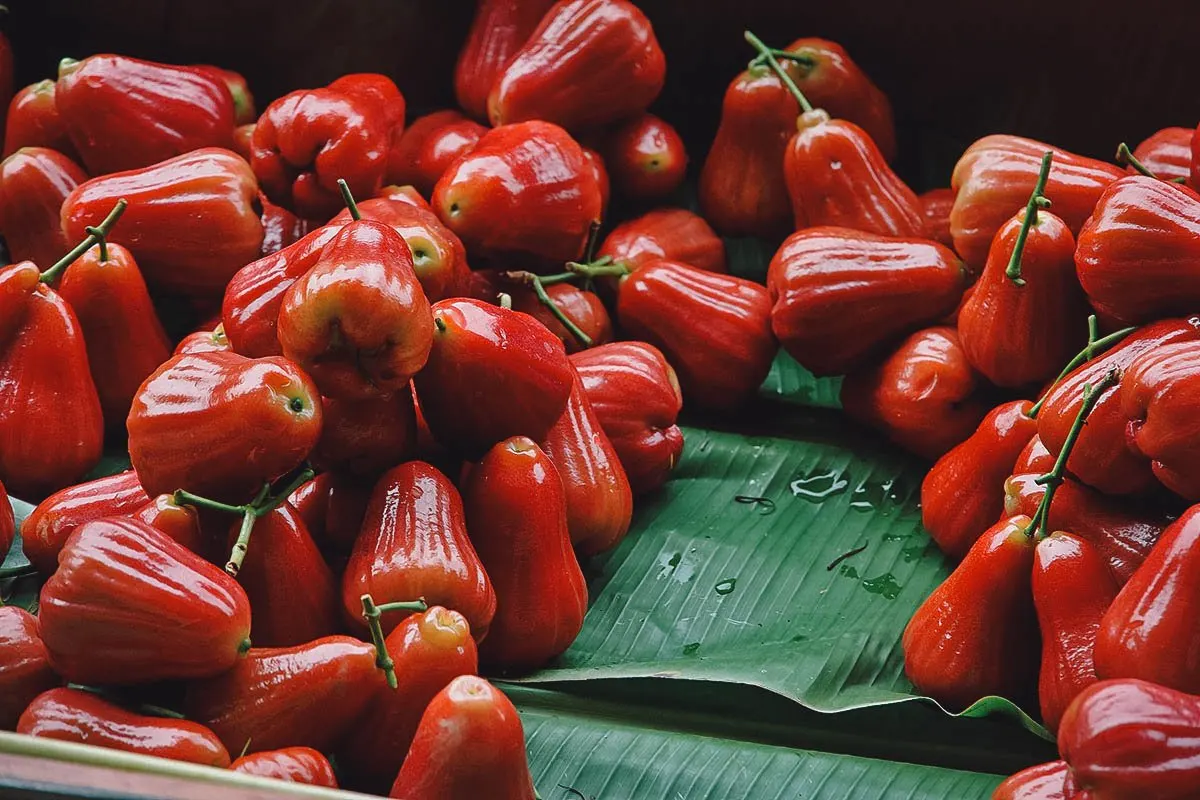
Photo by ponsulak
22. Jackfruit
Ever since I was a kid, the jackfruit has always been one of my favorite Filipino fruits. Large and heavy with a thick bumpy rind, it’s an exotic fruit that’s every bit as versatile as it is delicious.
Jackfruit is known locally as langka. When you break it open, you’ll find dozens of yellow waxy segments that contain seeds. When eaten raw, they’re sweet but not too sweet with a relatively dry and robust texture that’s soft but slightly crunchy.
Personally, I like it best when eaten raw but langka can also be bottled in syrup or used as an ingredient in savory Filipino dishes like ginataang langka (jackfruit cooked in coconut milk). When cooked, it maintains a firm, sinewy texture that’s reminiscent of meat.
Bottled langka is much sweeter than the fresh version and is often used as an ingredient in many Filipino desserts like turon, halo-halo, and ginataan.
Scientific name: Artocarpus heterophyllus
Filipino name: Langka
Jackfruit season in the Philippines: March to May
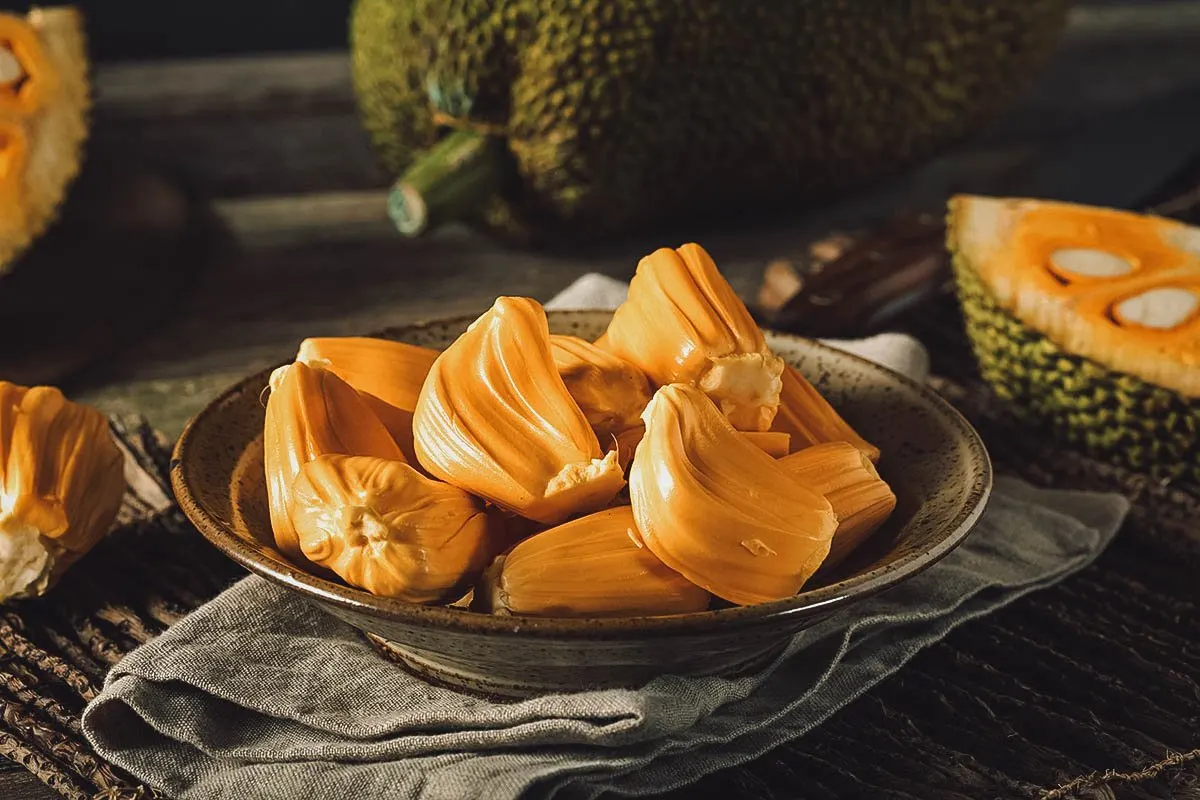
Photo by bhofack2
23. Papaya
Like mango, pineapple, cantaloupe, or watermelon, papaya is one of the more popular fruits on this list and needs little introduction. It’s originally from the Americas but it’s now cultivated in many tropical and subtropical parts of the world.
Ripe papaya is delicious but in the Philippines, as in many countries in Southeast Asia, unripe green papaya is often used as an ingredient in Filipino dishes like chicken tinola, lumpia, and ginataan. It’s also julienned and pickled to make atsara, a popular relish or side dish often paired with savory dishes.
Scientific name: Carica papaya
Filipino name: Papaya
Papaya season in the Philippines: Year-round
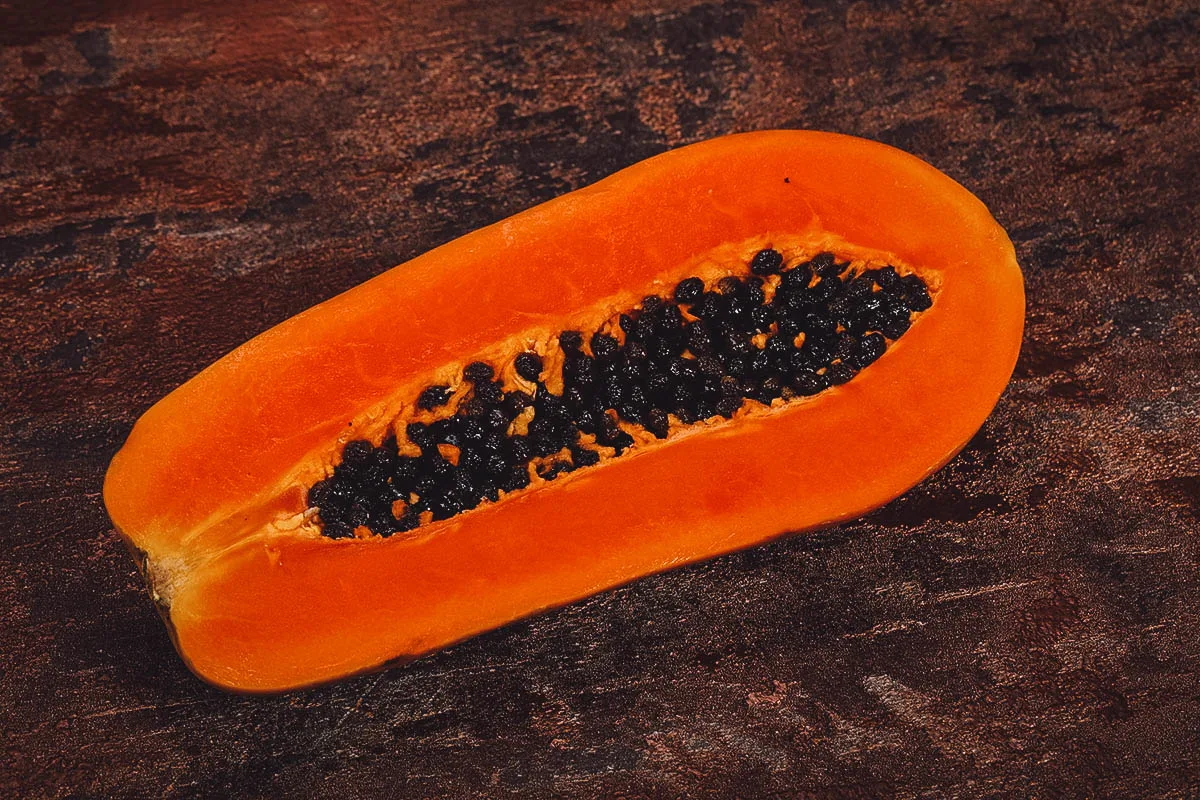
Photo by AndreySt
24. Bilimbi
Like macopa and bayabas, bilimbi (or cucumber tree, tree sorrel) is a fruit-bearing tree that many Filipinos have growing in their backyards. My in-laws have one. Called kamias in the Philippines, it produces small, oval-shaped green fruit with a crunchy texture and an extremely sour taste.
Rich in vitamins and minerals like vitamin C and B, calcium, and fiber, kamias is an edible fruit that’s commonly used as a souring agent in dishes like sinigang. The sour fruit can be eaten raw, but usually with rock salt to help temper the acidity.
Scientific name: Averrhoa bilimbi
Filipino name: Kamias
Bilimbi season in the Philippines: June and July
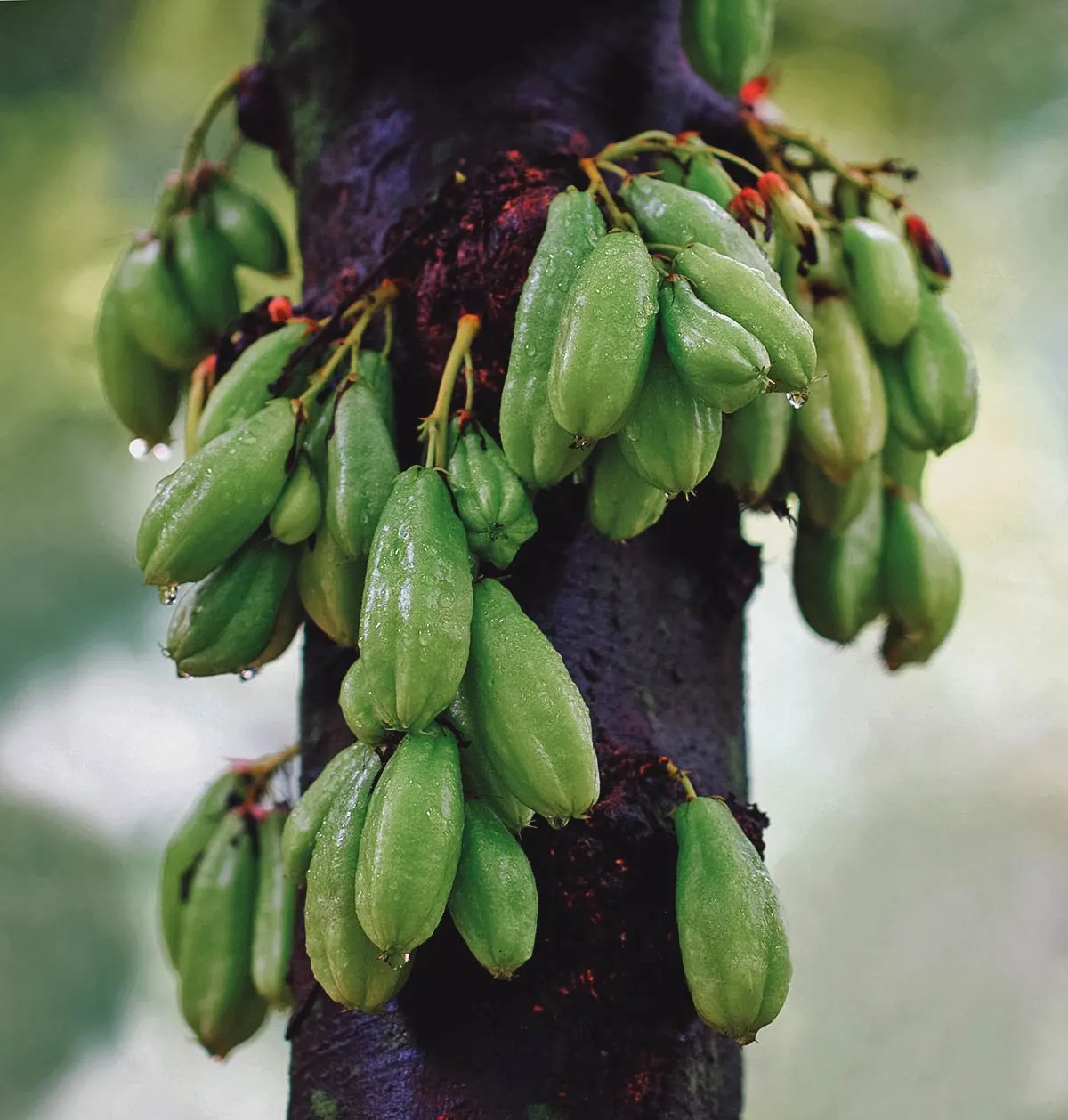
Photo by bdspn74
25. Star Apple
Star apple is one of my favorite Filipino fruits. Known locally as caimito, it’s round in shape with purplish-green skin and translucent flesh. It’s about the size of an apple but much softer in texture.
To eat, you slice the caimito in half and scoop up the fleshy fruit with a spoon before spitting out the seeds. The pulp is soft and sweet and absolutely delicious when chilled.
Scientific name: Chrysophyllum cainito
Filipino name: Caimito
Caimito season in the Philippines: January to March
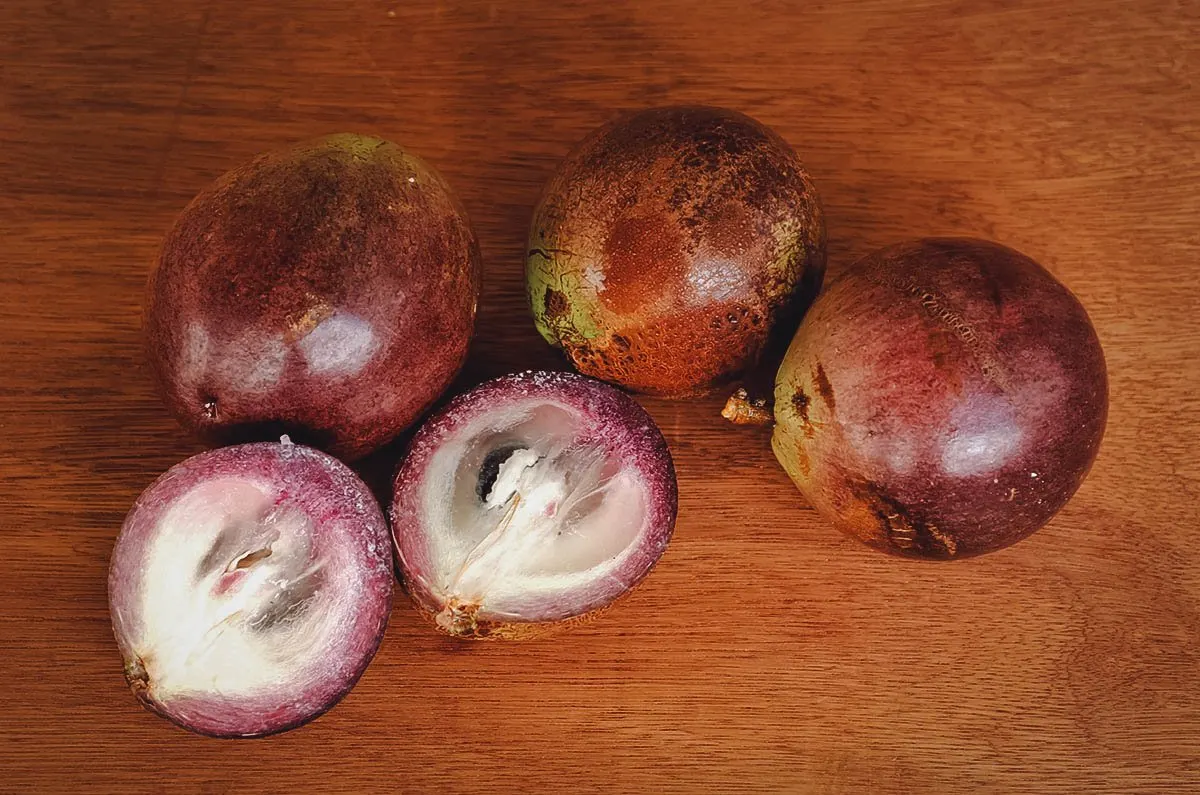
Photo by Jacdephotos
26. Pomelo
Pomelo is a large citrus fruit with yellow to reddish-orange flesh. Known locally as suha, it’s the principal ancestor of the grapefruit though it doesn’t have its characteristic bitter taste.
To eat suha, you rip apart its thick rind much like you would a mandarin orange. Its flesh is juicy and just mildly sweet and sour. Like kamias, it’s typically eaten with rock salt.
Scientific name: Citrus maxima
Filipino name: Suha
Pomelo season in the Philippines: Year-round
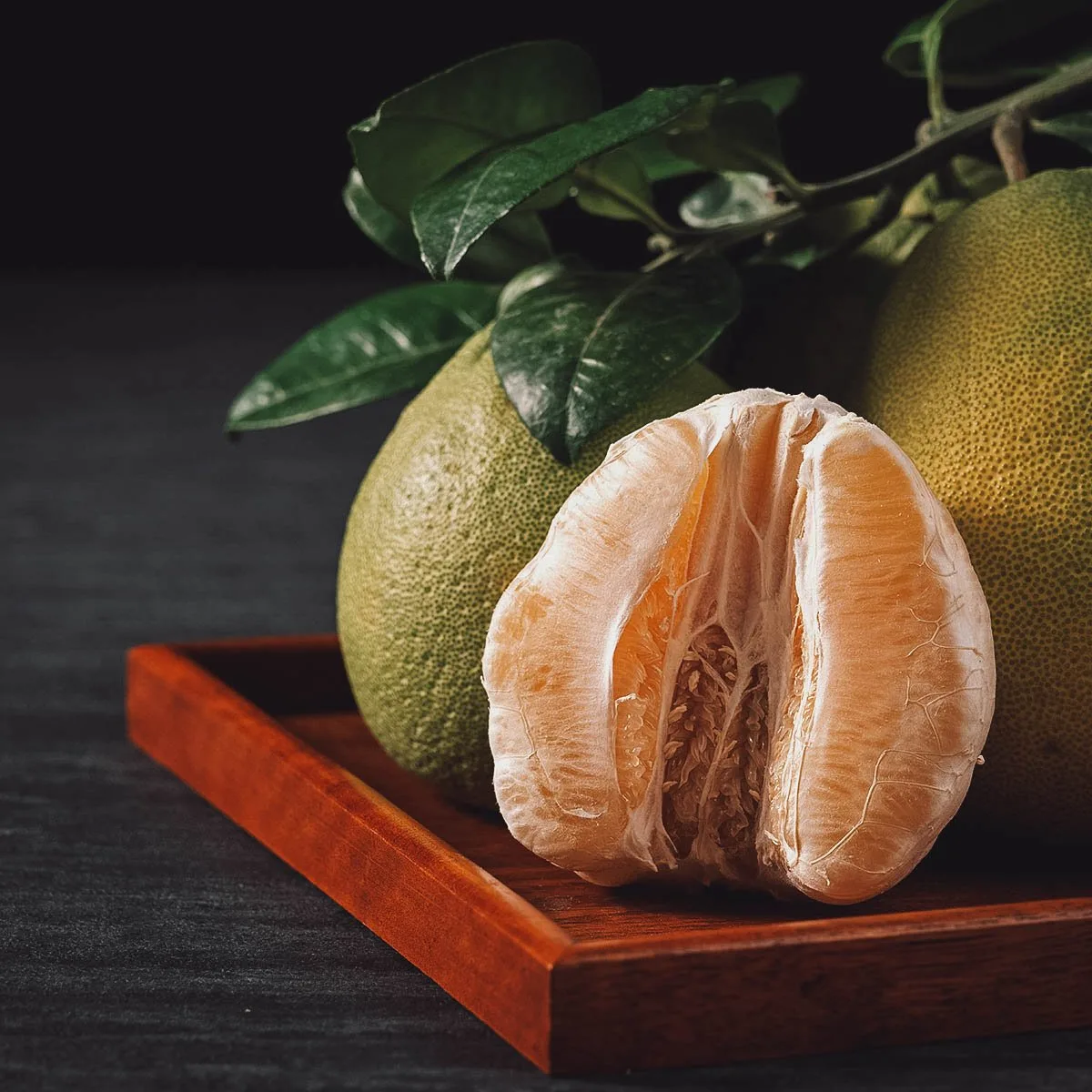
Photo by [email protected]
27. Spanish Plum
When fully ripe, there are some fruits like lanzones and longan that are so good that it’s hard to stop eating them once you start. Spanish plum or siniguelas is one of those fruits.
About the same size as rambutan, siniguelas have a waxy appearance and can vary in color from green to orange to red. The fruit is firm to the touch but softer than an apple, with edible skin and yellow juicy flesh. To eat, you bite into the siniguelas and eat around the hard seed inside. It’s an extremely juicy fruit with a deliciously sweet and sour taste.
Scientific name: Spondias purpurea
Filipino name: Siniguelas
Spanish plum season in the Philippines: April to June
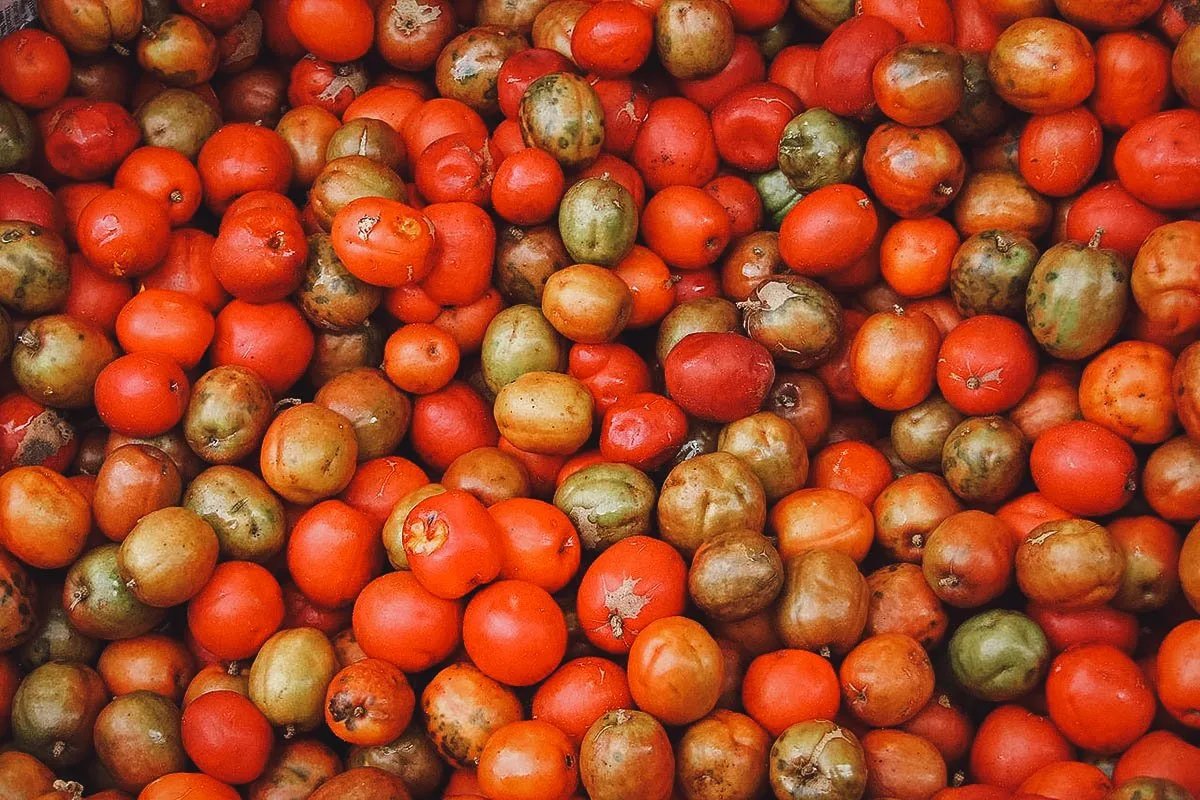
Elveoflight, CC BY-SA 3.0, via Wikimedia Commons / Processed in Photoshop and Lightroom
28. Tamarind
In Thailand, you can find a type of sweet tamarind that can be eaten raw with nary a hint of sourness. Not so much in the Philippines.
Known locally as sampaloc, tamarind in the Philippines is usually very sour and used mainly as an ingredient in many Filipino recipes, most notably sinigang. It’s the most common souring agent used to give this popular Filipino soup its characteristic acidity.
Scientific name: Tamarindus indica
Filipino name: Sampaloc
Tamarind season in the Philippines: October to December
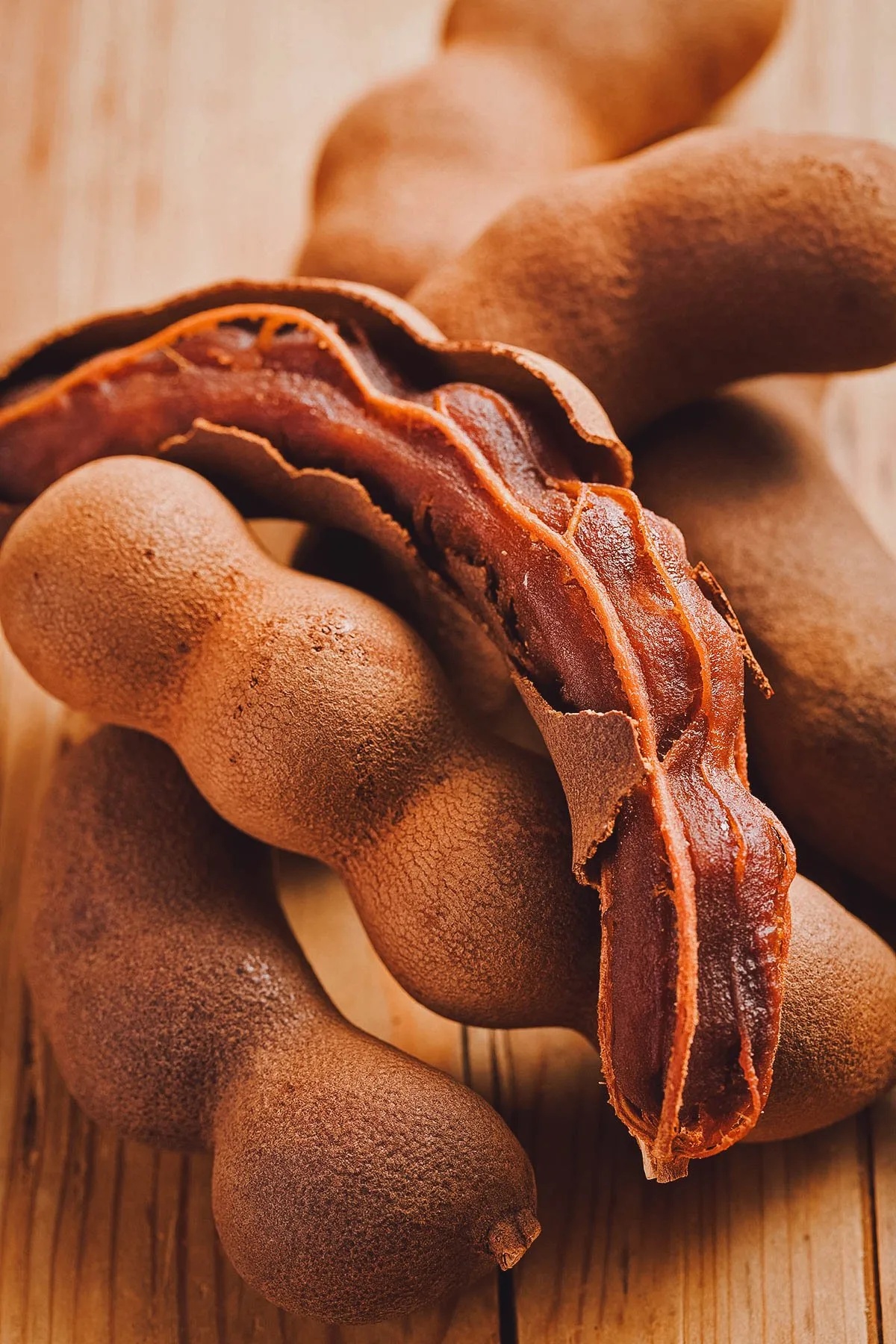
Photo by jirkaejc
29. Mangosteen
The mangosteen is a round fruit with a thick, leathery shell and soft white flesh. This exotic fruit is common in the Philippines and in other countries in the region like Thailand, Malaysia, and Indonesia.
To eat mangosteen, you cut through and around its thick skin with a knife while avoiding the delicate flesh inside. You’ll find about 5-8 segments of fruit. The biggest ones will have a seed in the middle which you can spit out after eating the flesh around it.
Depending on its quality and degree of ripeness, mangosteen has a sweet taste with hints of acidity. The higher the quality, the less sour it tastes.
Scientific name: Garcinia mangostana
Filipino name: Mangosteen
Mangosteen season in the Philippines: June to November
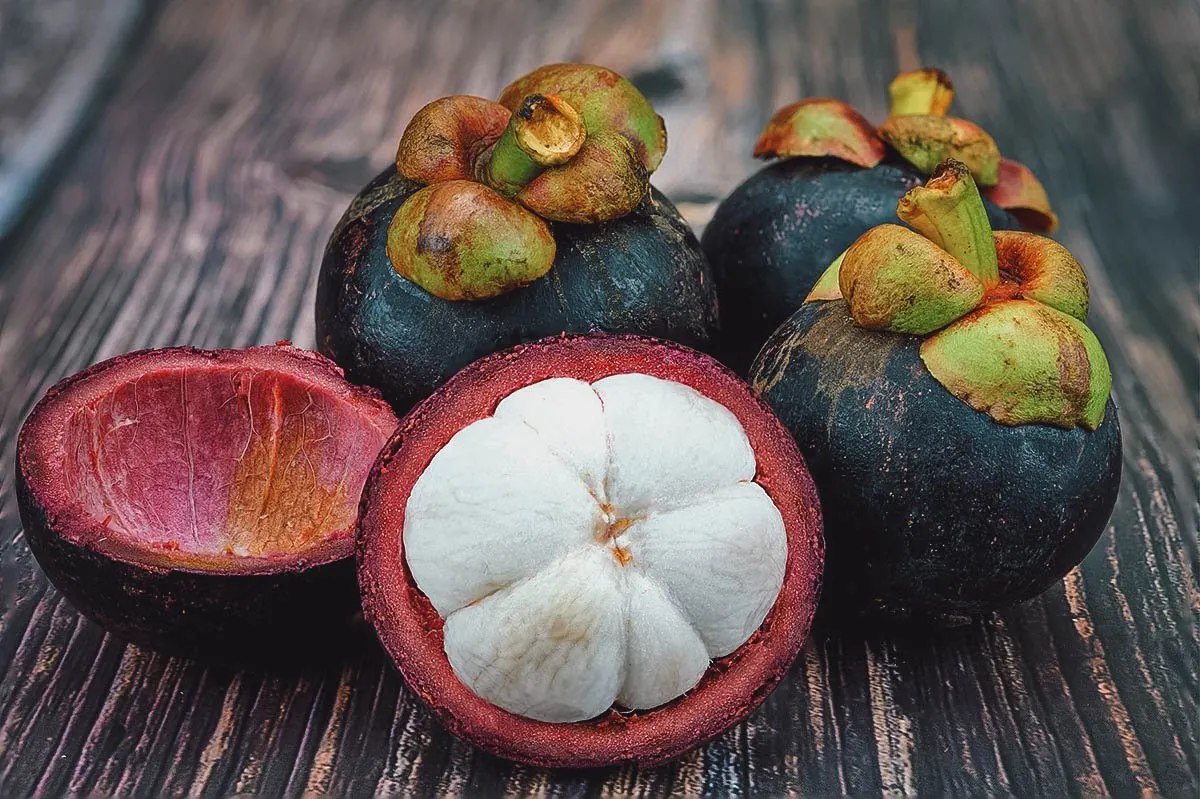
Photo by somchaichoosiri
30. Key Lime
Key lime is well known to westerners but it actually has its roots in Southeast Asia. In the Philippines, it’s known as dayap.
Like calamansi, dayap isn’t typically eaten on its own. Instead, it can be used as an ingredient in some Filipino pastries and desserts like leche flan.
Scientific name: Citrus × aurantiifolia
Filipino name: Dayap
Key lime season in the Philippines: August to November
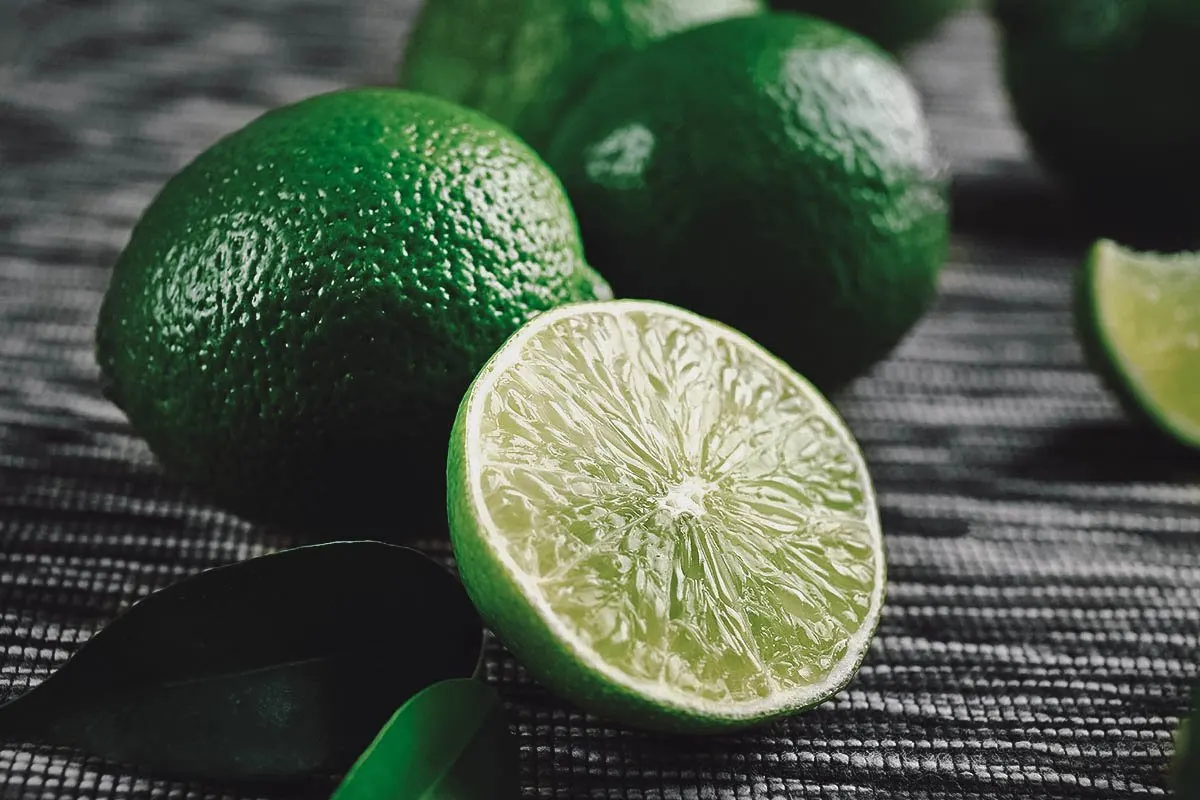
Photo by belchonock
FINAL THOUGHTS ON FILIPINO FRUITS
All these fruits are interesting in their own right and worth trying if you’re curious about food. However, not all fruits mentioned are as good when eaten ripe. Some like sampaloc, kamias, and saging na saba are best sampled in Filipino cooking.
If you could try just three fruits in the Philippines, then I’d tell you to go for mangoes (Guimaras!), custard apples, and star apples. Personally, these are the fruits I will always look for when they’re in season.
One last thing, I never knew this but egg fruit or canistel is apparently common in the Philippines as well. I’ve never had it here but I’ll definitely look for it on my next trip to the local markets!
Disclosure
Some of the links in this article on Filipino fruits are affiliate links, meaning we’ll get a small commission if we make a sale at no added expense to you. We only recommend products and services that we use ourselves and firmly believe in. We really appreciate your support as this helps us make more of these free travel guides. Thank you!
Featured photo by bhofack2. Stock images via Depositphotos.


Natalie
Tuesday 23rd of January 2024
I appreciate this piece! My husband spent time in the Philipeans as a child. He was describing various fruits & didn't know the names, and I started poking around & found this. We found every one! This was great and helpful.
JB & Renée
Monday 29th of January 2024
Happy to hear you found it useful Natalie!
Laly
Saturday 7th of October 2023
It’s fascinating and I talk about it with my friends always, that in South America we have most of the fruit you mentioned only 4 I haven’t seen there grow in the garden. Also people from some region we are with physical similarities, personally I get ask frequently if I am Pilipino, I think all is related with the geography position and history. My family are from Colombia and Venezuela, I am living in England and many of my friends (I know around 19 years) are Pilipino or from Asia they are like my family. Beautiful happy people 💕
JB & Renée
Saturday 21st of October 2023
Thanks for sharing Laly! Love hearing stories like that. Yes, I agree that Filipinos share many cultural similarities with Central and South Americans. It's part of the reason why I enjoy exploring that part of the world. It reminds me of home in so many ways!
Laly
Saturday 7th of October 2023
custard apples In South America name is Anon, love them my grandparents use to have a tree and it is very popular to have in the garden in the coastal area of Colombia.
Ronaldo Santos
Sunday 30th of April 2023
You didn't mention Marang from Mindanao.
Eddie Bologna
Thursday 12th of January 2023
As an Amerikano who is married to a Filipina I have tried most of these fruits. I love them all with the exception of Durian that I will not even allow in our home. It smells terrible. I have a rule that I live by, " if it doesn't look good or doesn't smell good, I will never dare to see if it tastes good". By the way, the same goes for dried fish, "yuck"......
JB & Renée
Thursday 12th of January 2023
Haha you're certainly not alone Eddie! :D